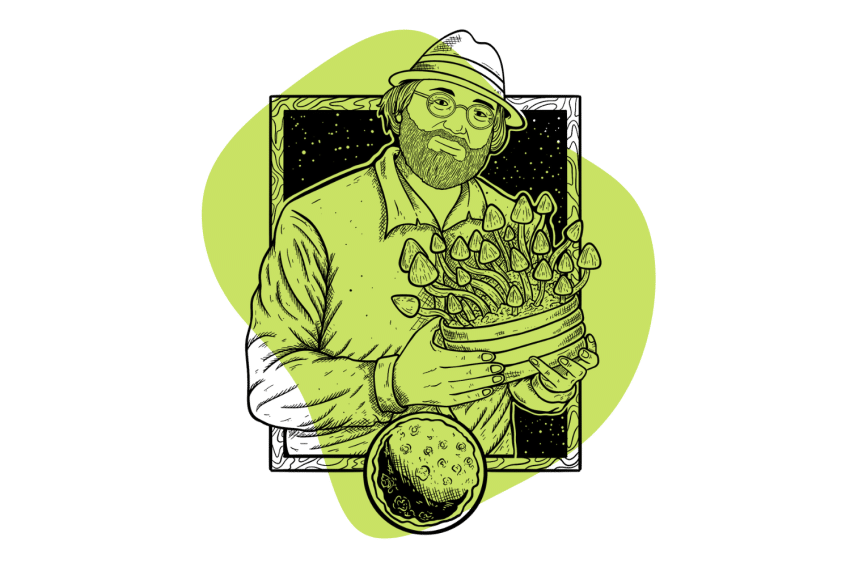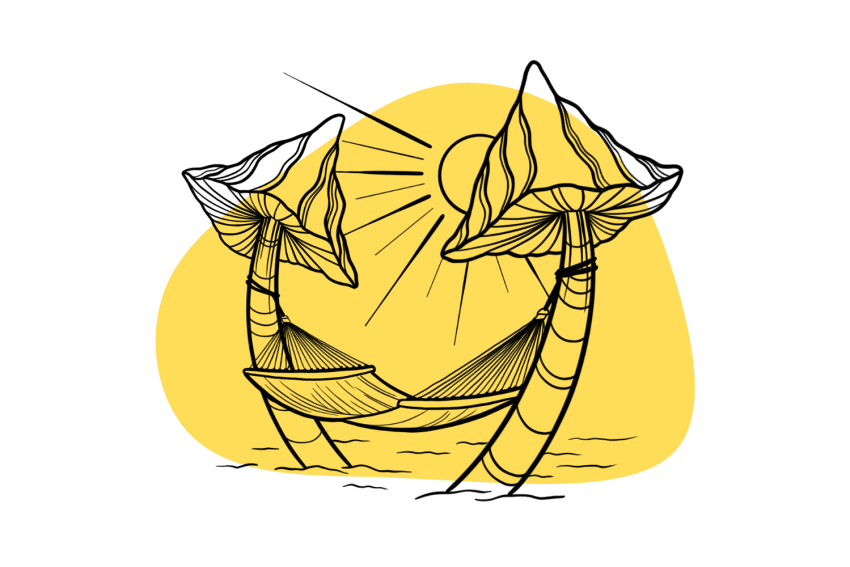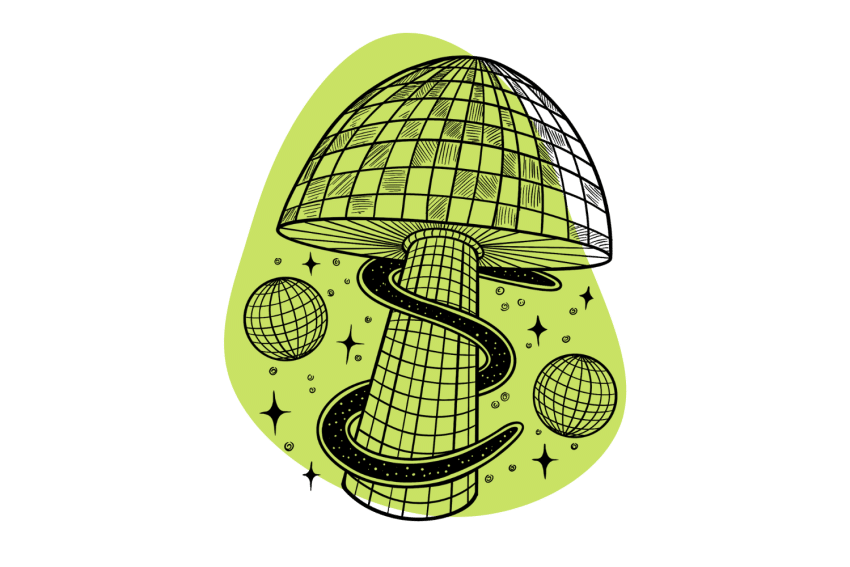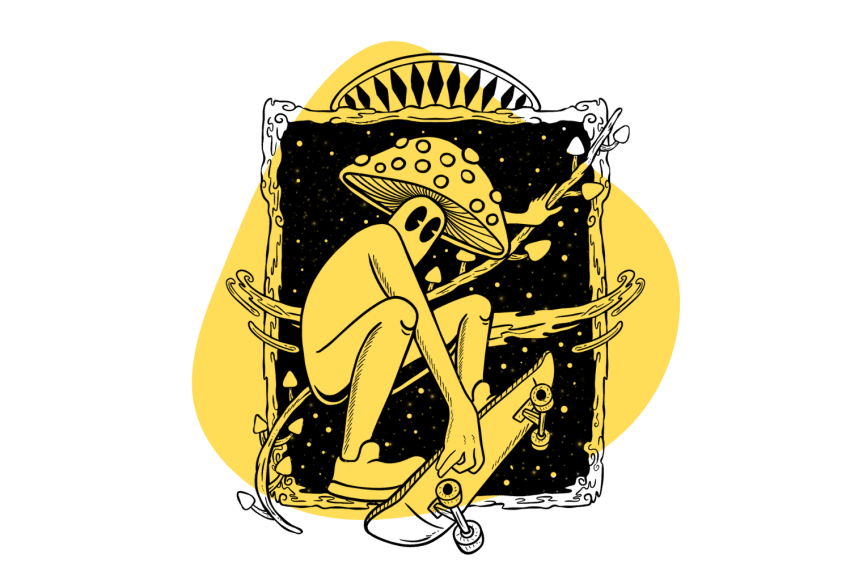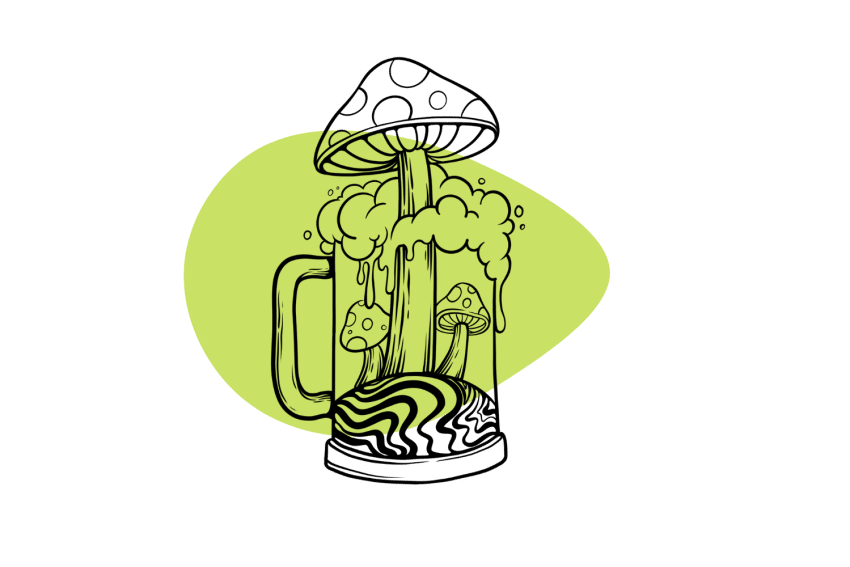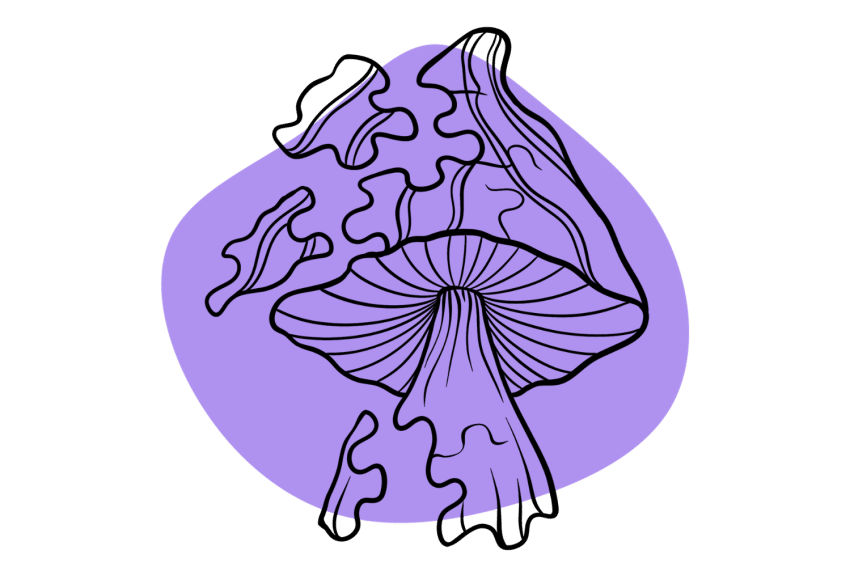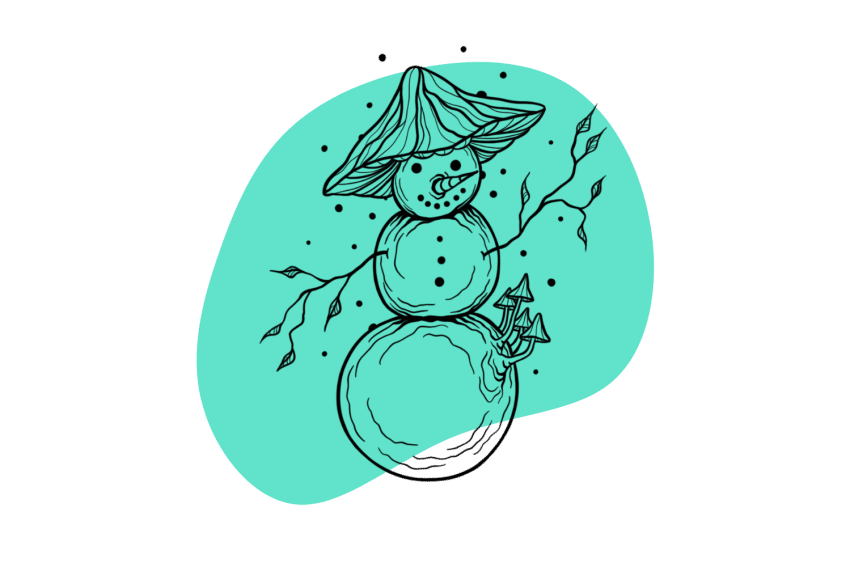Where Do Shrooms Grow? How to Find Magic Mushrooms in the Wild
Psilocybin-containing mushrooms grow on every continent on Earth, with the exception of Antarctica. Learn where to find wild magic mushrooms near you.
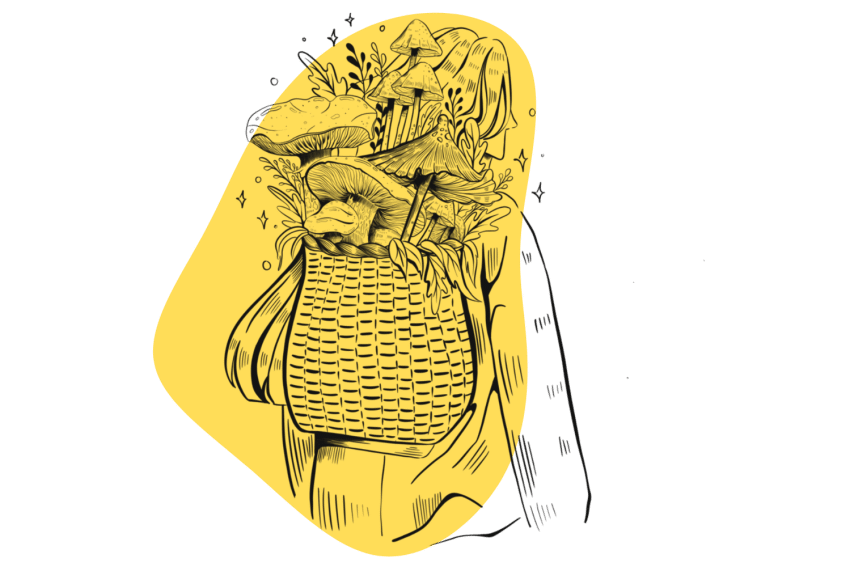
Magic mushrooms grow just about anywhere humans live. They love growing in the disturbed areas surrounding new developments, and they thrive on the byproducts of agriculture — such as manure, crop refuse, and compost.
In fact, you’re more likely to find magic mushrooms near areas of human development than you are in the middle of undisturbed old-growth forests.
Today, psilocybin-containing mushrooms have naturalized all over the world. Learning where shrooms like to grow and what species to be on the lookout for (and their poisonous lookalikes) is key to successful foraging.
Magic Mushrooms Coexist With Humans
Magic mushrooms are saprophytes, which means they live off dead or decaying organic matter. They thrive in areas where the environment has been disturbed or damaged.
Historically, magic mushrooms were isolated to small pockets throughout forests and grasslands and would flourish after natural disasters caused death and destruction to the local environment. This damage provided mushrooms and other decomposers with an influx in food.
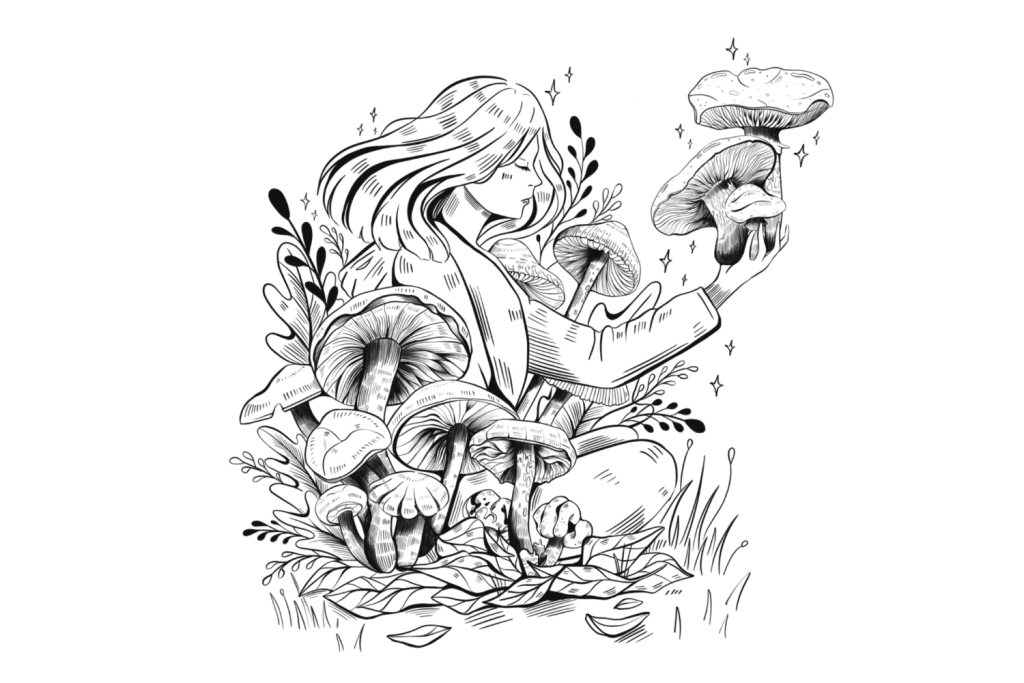
Since the formation of human civilization, saprophytic mushrooms have capitalized on our proclivity to dismantle the environment. In effect, what humans do to the environment has replaced the need for mushrooms to rely on natural disasters.
As such, you can find many species of magic mushrooms growing wherever humans live. They’re often found around new developments, parks, pastures, farms, and grasslands near towns and cities.
The psychedelic nature of magic mushrooms provides another reason for humans to give them special treatment. Today, there are entire markets built on the cultivation and distribution of psychedelic fungi. Spores are collected and shipped around the world to professional and amateur growers alike. Once these mushrooms reach maturity, the spores are disbursed into the air, eventually settling in a park or field nearby.
Related: Where to Buy Magic Mushroom Spores.
Where Do Magic Mushrooms Grow? Climate & Habitat
If you’re interested in hunting down some magic mushrooms in the wild, it’s important to understand where and when they’re most likely to be found.
Different species of mushrooms can be found according to the macroclimate and local habitats. The seasons and ambient weather patterns can also play a role in what mushrooms are most likely to be available at any given moment.
Climate Zone
Psilocybin-containing mushrooms are generalists (mostly) — they tend to accept a wide range of food sources and climate conditions. This is aided by their tendency to live under the soil, where they’re sheltered from droughts, heavy rains, and fluctuations in temperature.
The only place you won’t find magic mushrooms in any capacity are the poles, where it’s simply too cold, and there isn’t enough organic material for the mushrooms to feed on.
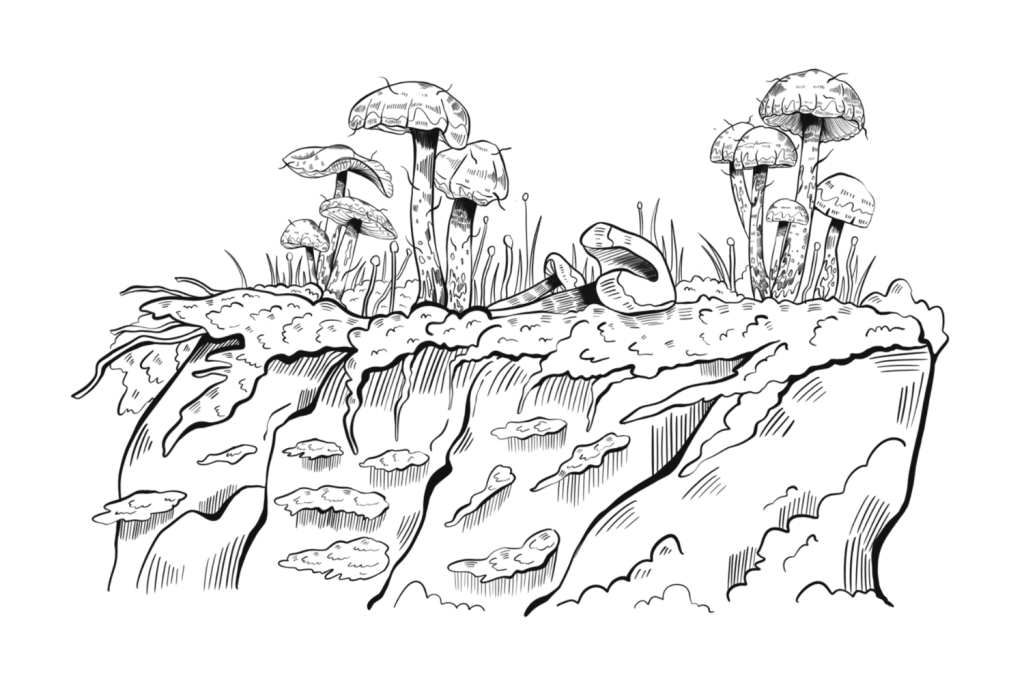
There are eight major climate zones that affect which species of mushrooms you’re most likely to discover in the wild:
- Tropical Wet — Many species in the Psilocybe and Panaeolus genus are found in this climate.
- Tropical Dry — Psilocybe and Panaeolus genus’ common in this climate.
- Arid — Magic mushrooms aren’t common in this climate.
- Semi-Arid — Psilocybe hopii, Psilocybe cyanescens, and Panaeolus cinctulus are the most common.
- Subtropical Humid — Panaeolus fimicola and various Gymnopilus species are common.
- Subtropical Dry — Common species include Psilocybe cubensis, P. zapotecorum, and P. tampanensis.
- Temperate — Psilocybe cyanescens, P. semilanceata, and Panaeolus cinctulus common.
- Arctic — Magic mushrooms aren’t common in this climate.
Habitat
Just because the climate is right doesn’t mean you’re going to find magic mushrooms growing all over the place. They need the right amount of light, humidity, and source of food to thrive.
In general, magic mushrooms prefer sheltered and humid areas with plenty of organic material for them to eat.
The easiest place to find magic mushrooms is around pastures. Many species prefer living in manure or manure-rich soil, and those that don’t will thrive on the decaying grass or crop refuse.
You can also find magic mushrooms in temperate forests with plenty of leaf litter.
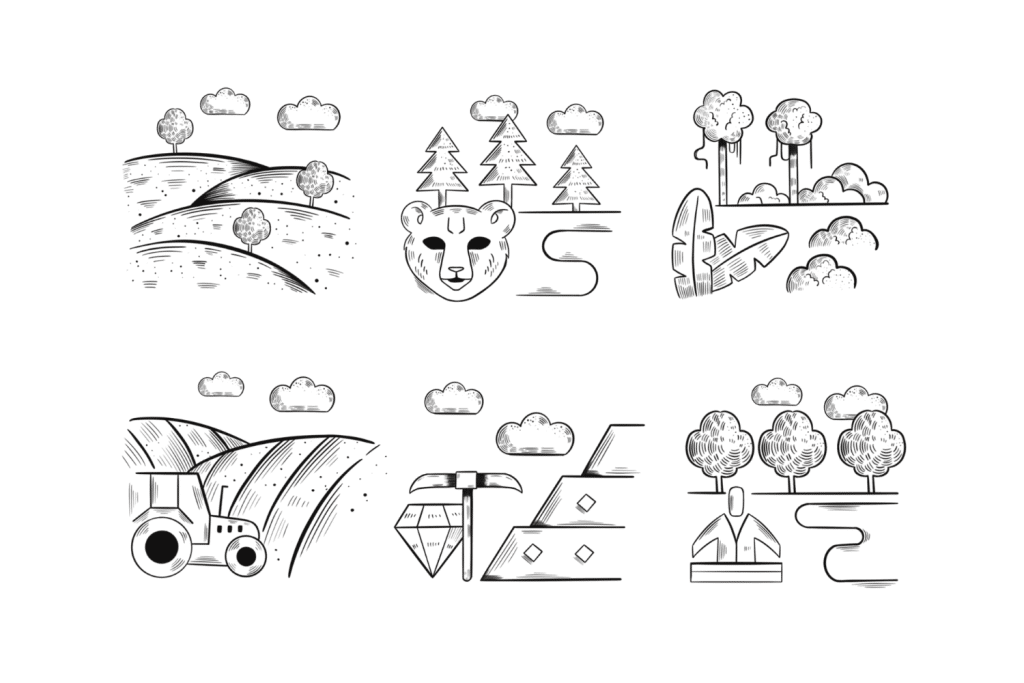
In more arid regions, some species survive by living inside decaying wood where it’s dark, humid, and protected from the hot sun during the day.
You can also find magic mushrooms popping out of the soil around parks and gardens — especially in soil enriched with manure, compost, or wood mulch.
Which environments do magic mushrooms prefer?
- Grasslands
- Wet swampy lowlands
- Pastures (dung deposits)
- Riparian zones (disturbed habitats, parks, & gardens)
- Temperate woodlands
- Tropical woodlands
Weather Conditions
The ambient weather can have a big impact on when mushrooms decide to fruit.
Most species of magic mushrooms will wait for a few days of rain before they start to send up their fruiting bodies from under the ground. For this reason, experienced mushroom foragers will often wait for a day or two of back-to-back rain before they head out on a forage.
The exceptions are species harvested for their sclerotia (aka magic truffles). Species such as Psilocybe tampanensis produce hardened sclerotia after periods of drought.
Season
Depending on what species you’re hunting for, it’s important to know what season they tend to fruit in. Some species will send up new mushrooms regularly throughout the spring, summer, and fall (such as Psilocybe cubensis and Psilocybe semilanceata), while others fruit during a particular season every year.
The seasonality will depend on the local climate, so it’s hard to make generalizations according to the species. For example, Psilocybe cyanescens requires a drop in temperature before it fruits — so it’s more common in the winter and early spring in California but more common in the late summer or fall in Canada and Northern United States.
Wild Magic Mushrooms vs. Cultivated Magic Mushrooms: Pros & Cons
Most of the magic mushrooms you’ll find for sale were grown indoors, not picked from outside. It’s surprisingly easy to cultivate magic mushrooms at home, so most people opt for growing them rather than trying to find them outdoors.
Growing certain species like Psilocybe cubensis or Panaeolus cyanescens can be done cheaply and without the need for professional training or expertise.
If you’re looking for a steady source of magical fungi, you’re better off growing them from spores than picking them from the wild.
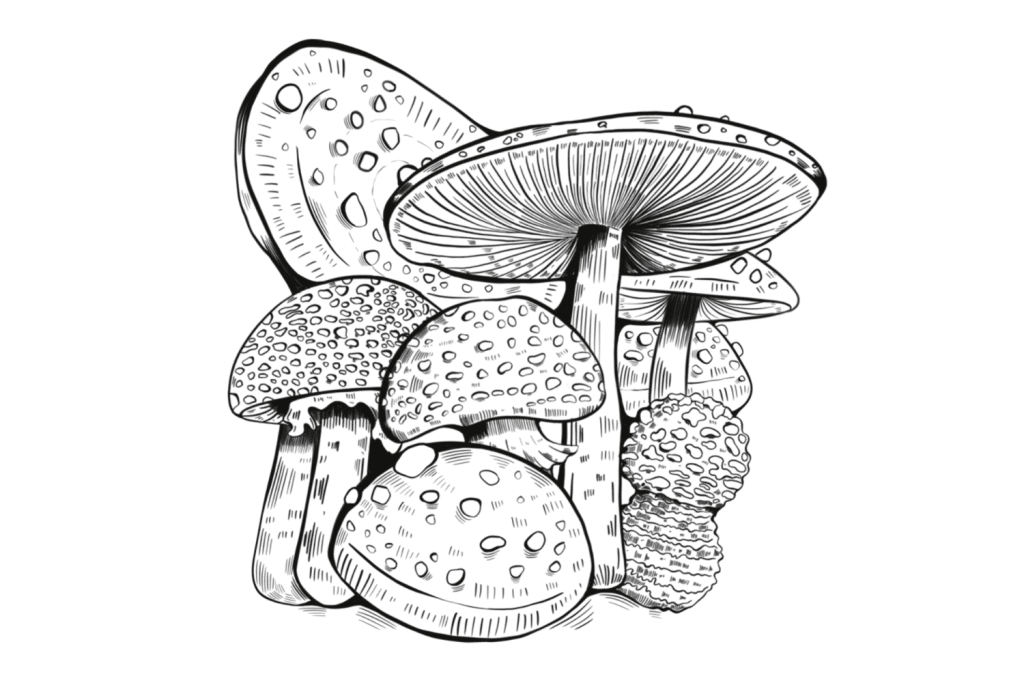
Cultivating Magic Mushrooms Pros & Cons:
- PRO: It’s significantly harder to mistakenly take poisonous lookalikes.
- PRO: You can get a consistent supply of mushrooms all year long.
- PRO: Growing magic mushrooms is an excellent way to learn about them.
- CON: You’re limited in the species you can cultivate (Psilocybe cubensis or Panaeolus cyanescens)
- CON: Getting started with growing is cheap but not free. You’ll need to buy some equipment to get started.
Foraging Magic Mushrooms Pros & Cons:
- PRO: Foraging magic mushrooms is an excellent excuse to get out into nature.
- PRO: You can find magic mushrooms in the wild that aren’t common or easy to cultivate indoors.
- PRO: Finding magic mushrooms yourself is one of the best ways to learn about them.
- PRO: Foraging for mushrooms yourself adds to the spiritual significance of the experience.
- CON: You need to be very cautious of poisonous lookalikes.
- CON: Foraging for magic mushrooms isn’t always easy, and many times you won’t find any at all.
What You’ll Need to Forage For Magic Mushrooms
You really don’t need much to get out into the wild to start foraging for mushrooms. The most basic pieces of kit include a good mushroom guidebook, a knife, some tinfoil (for taking sporeprints), a basket to collect the mushrooms, and some weather-appropriate clothing.
Mushroom Guidebooks
My favorite guidebook is The Field Guide to Mushrooms by The National Audubon Society (General Mushroom Guide). This book is extensive, and while it can take some time to get a feel for how it’s organized, it’s hands-down the most thorough book on the market for all species of fungi.
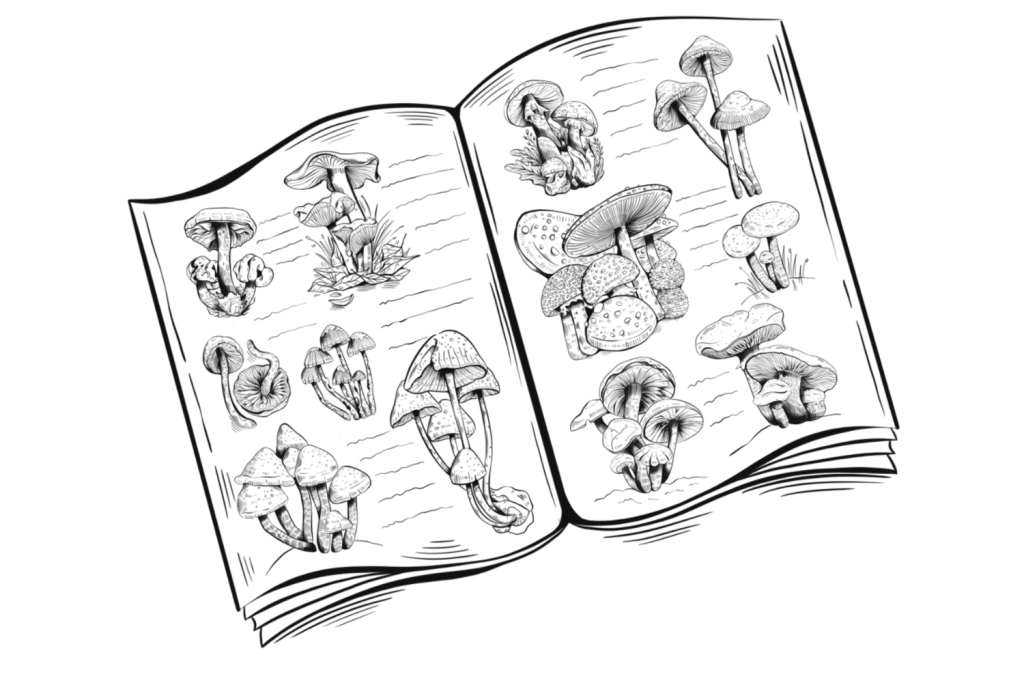
A decent magic mushroom-specific book to carry around as a supplement to this is Paul Stamet’s book, Psilocybin Mushrooms of the World.
A Knife
A small, sharp knife is recommended to help separate the mushrooms from the ground without tearing them up. This removes the fruiting parts of the mushrooms without damaging the mycelium below.
You’ll also use your knife to cut out any visible grubs or bacteria that may be living on the mushrooms you harvest.
Tinfoil
Part of mushroom identification involves taking a spore print. Cut the head off the mushroom and place it with the gill side down on the tinfoil. You can either wait for the spore print on the spot or wrap it up in the tinfoil and toss it into your basket to assess later.
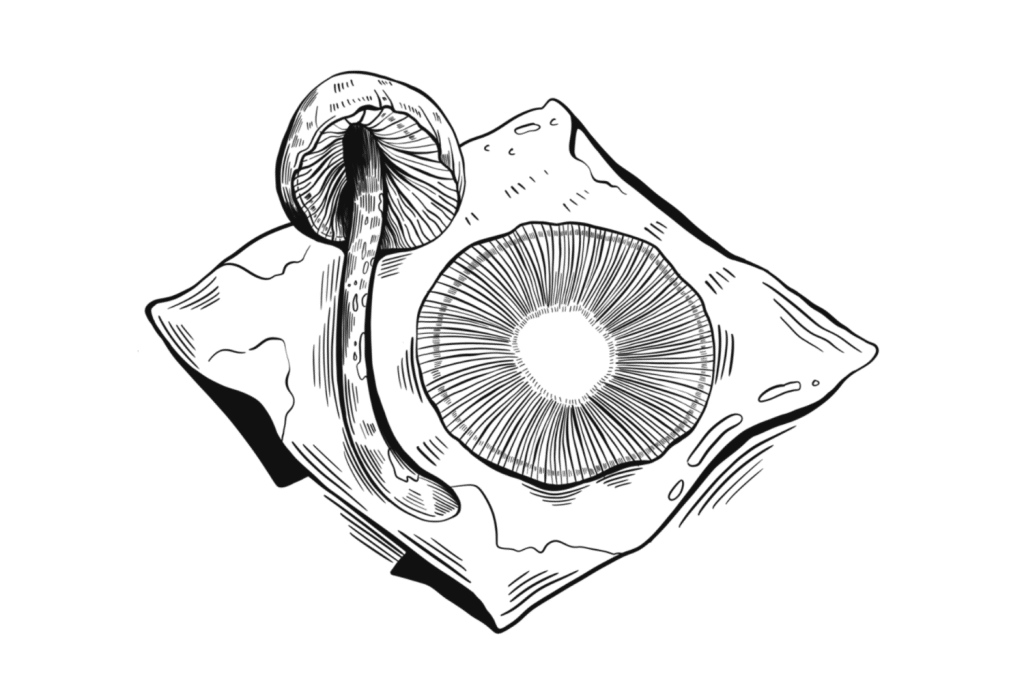
Paper or plastic sheeting works for this as well. Basically, any light-colored, flat surface will work.
Collection Basket
Mushrooms reproduce via their spores, so you’ll want to find a container to keep your mushrooms in that allow the spores to spread as you walk through the forest.
Wicker baskets work great for this, but you can also simply drill some holes in the bottom of a plastic bucket to achieve the same effect.
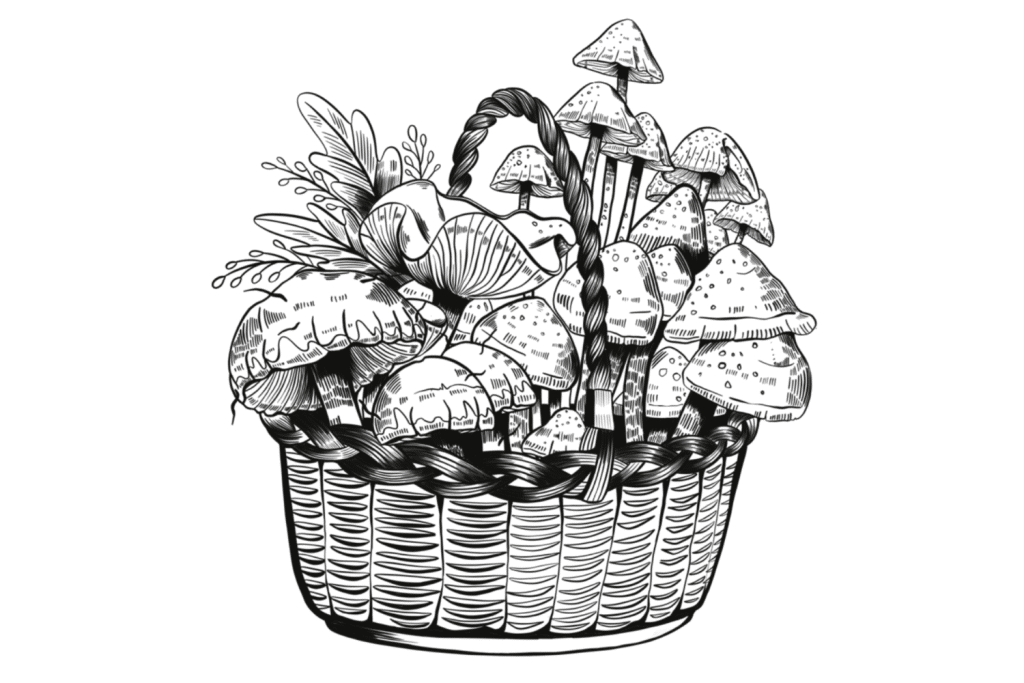
Avoid using plastic bags to collect your mushrooms. Over the course of the day, the humidity may increase too much and lead to the rotting of the mushrooms before you even make it home with your harvest.
Popular Mushroom Species & Where They Grow
There are more than 180 individual species of psilocybin-containing fungi, most of which are found in the subtropics and tropics, but there are plenty that thrives in the cooler or drier regions of the world too.
Here are the 8 most common species of psychedelic fungi you’re most likely to find on your next foraging adventure.
1. Psilocybe cubensis
| Where it grows | Almost everywhere |
| Strength | ?? |
| Where to look | These shrooms prefer growing in manure, so you’ll likely find them near ranches, gardens, or parks that use manure for fertilizer. |
| Cultivation difficulty | Easy |
Psilocybe cubensis is the most commonly cultivated species of magic mushrooms, by far. Common strains of Psilocybe cubensis sold for home cultivation include Golden Teachers, Penis Envy, Orissa India, and many others.
The popularity of these mushrooms in the underground mushroom cultivation scene has allowed them to spread far and wide. Spores attach to those growing and consuming them, which are then spread around the local environment.
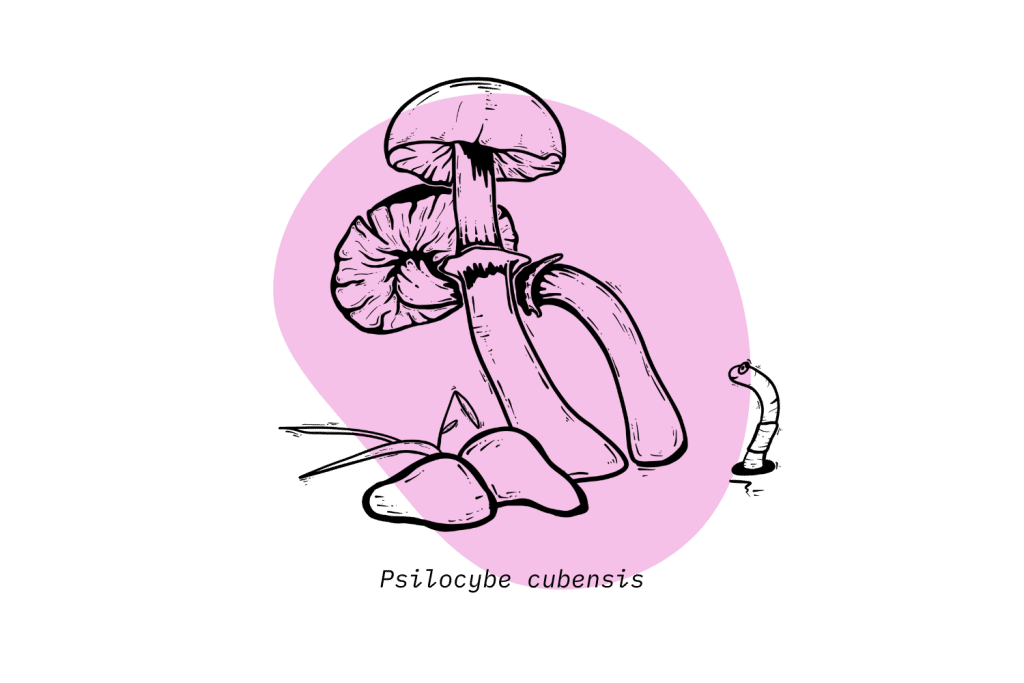
Every time someone opens a bag containing Psilocybe cubensis, some of the spores escape — potentially landing in an area suitable for further growth and development.
Today, Psilocybe cubensis can be found in virtually every region of the world. They prefer growing around parks, pastures, and grasslands but can also be found in wooded areas and urban environments.
2. Panaeolus cyanescens
| Where it grows | Warmer, East Coast regions of the US as well as Australia |
| Strength | ??? |
| Where to look | Another dung-loving species most often found near ranches, public parks, or community gardens. |
| Cultivation difficulty | Moderate |
Panaeolus cyanescens is the strongest member of the Paneaolus genus, most commonly found in tropical and subtropical climates.
Much like Psilocybe cubensis, Panaeolus cyanescens is a dung-loving species most commonly sighted in grasslands near pastures where there’s plenty of animal dung to feed on.
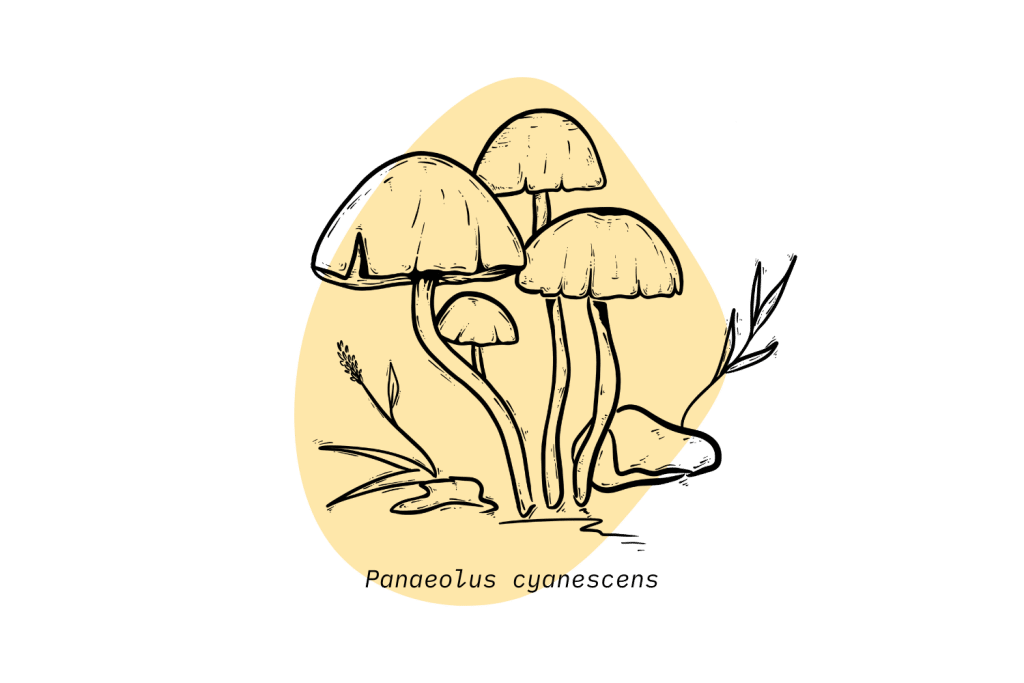
This species is most common in the warmer, East Coast regions of the US, from South Carolina down to central and South America. It can also be found growing throughout the Caribbean and Southeast Asia around Thailand and Laos.
There are also reports of this mushroom sighted along the subtropical Eastern Coast of Australia around Queensland and the Northern Territory.
3. Panaeolus cinctulus
| Where it grows | Throughout North America, the Mediterranean, and Australia |
| Strength | ?? |
| Where to look | These shrooms will grow just about anywhere. Look for them near grasslands, pastures, parks, wooded areas, and in urban environments next to buildings, parking lots, and walkways. |
| Cultivation difficulty | Moderate |
Panaeolus cinctulus is one of the most common species of magic mushrooms in the United States. In the early 1900s, it was even referred to as a weed because it was often found growing in the beds of commercial white button mushrooms and had to be picked out by hand before the mushrooms could be sold.
It’s likely the result of their association with commercial mushroom farms that has allowed these mushrooms to become so omnipresent in the United States. Even though the mushrooms themselves would be removed prior to packaging and shipping commercial food mushrooms, the spores would remain and piggy-bag across large distances via the supply chain.
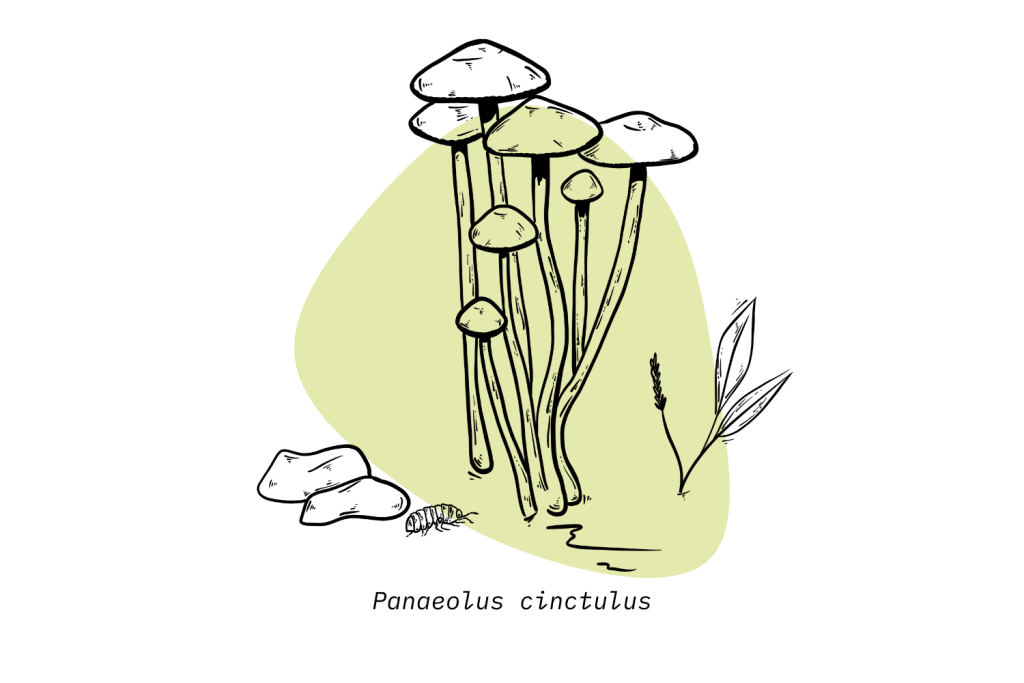
Panaeolus cinctulus can be found in all 50 US states, as well as Southern regions of Canada and the entire British Columbia coast up to Alaska. It’s also common in Mexico, Southeast Asia, South and Central America, the Mediterranean, New Zealand, and Australia.
These mushrooms grow in clumps out of soil rich in decaying manure and plant matter. It’s common in virtually all landscapes mushrooms are found in, including grasslands, pastures, parks, wooded areas, and in urban environments next to buildings, parking lots, and walkways.
4. Psilocybe semilanceata
| Where it grows | West coast of North America and Eastern Europe |
| Strength | ??? |
| Where to look | Liberty Caps grow most abundantly in open fields and pastures, but can also be found in wooded areas near small towns or cities. |
| Cultivation difficulty | Moderate |
Psilocybe semilanceata (AKA “Liberty Caps”) is one of the most potent species of psilocybin-containing fungi.
This species is common in North America on the West Coast from California to British Columbia and in smaller pockets on the East Coast (especially around Nova Scotia and Newfoundland, Canada).
Liberty caps are also common in Central and Eastern Europe — ranging from Spain and Portugal up to Estonia and Southern parts of Finland.
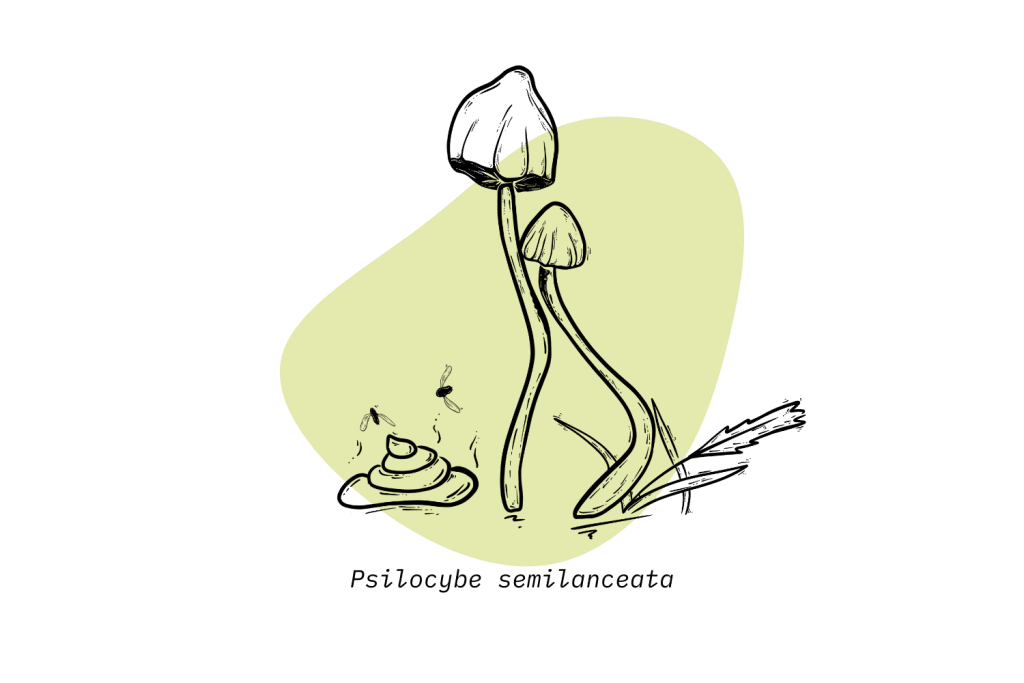
These mushrooms can also be found in New Zealand and South Africa and just about everywhere in between (albeit less common than North America and Europe).
This species can feed on just about any decaying plant matter and is most common in fields and pastures. It’s also one of the more popular species used for indoor cultivation, which is likely one of the reasons why this species is so pervasive in environments surrounding large cities.
5. Psilocybe zapotecorum
| Where it grows | Tropical and subtropical forests in the Southern United States, Mexico, down to Central and South America. |
| Strength | ??? |
| Where to look | These shrooms are most abundant in muddy or swampy regions of tropical and subtropical forests where it’s cool, dark, and humid. |
| Cultivation difficulty | Moderate |
Psilocybe zapotecorum is one of the most common species of magic mushrooms found in central and south America. It’s believed to be the main species used in Mexico by the Aztec and Mayan civilizations.
You can find these mushrooms in pastures and tropical forests from Southern Mexico down to Brazil and Colombia.
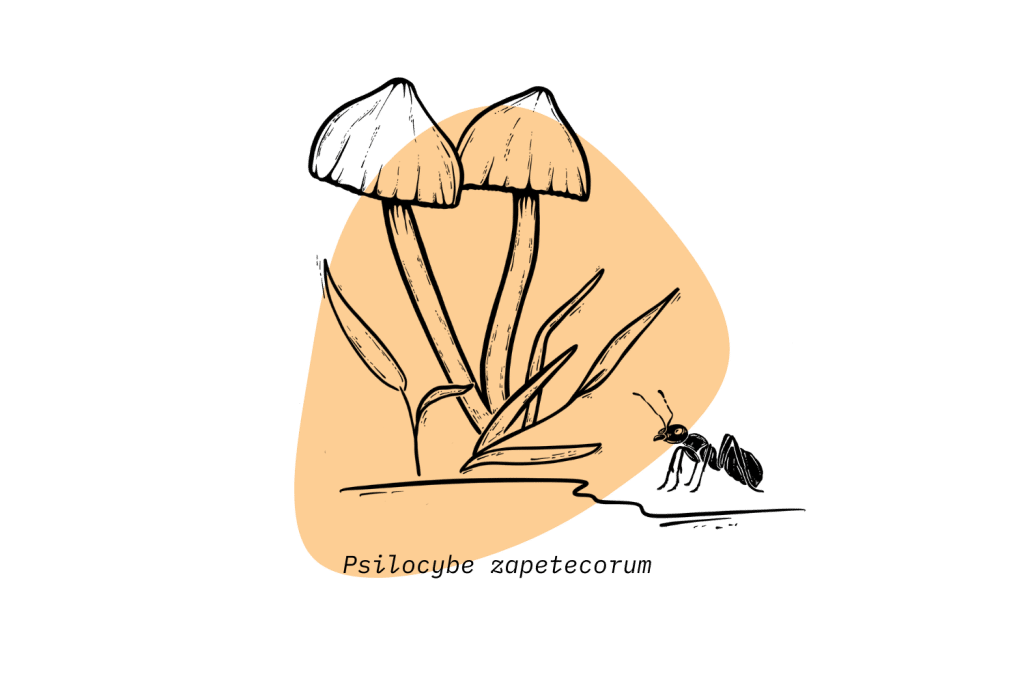
They’re difficult to spot due to the dark-colored tops and thin build. They’re often found growing in muddy or swampy regions of tropical and subtropical forests where it’s cool, dark, and humid — or around shaded areas of coffee plantations up to 1500 m.
These mushrooms are roughly twice as strong as Psilocybe cubensis.
6. Gymnopilus sp.
| Where it grows | Almost everywhere. |
| Strength | ?? |
| Where to look | There are dozens of species in this genus that are psychoactive. You can find at least one of them in virtually all environments aside from arid deserts and arctic climates. |
| Cultivation difficulty | Moderate |
Gymnopilus is a large genus containing around 150 individual species — more than half of which are found in North America.
There are several species within this genus that contain psychoactive concentrations of psilocybin and psilocin, and numerous others that are completely inactive.
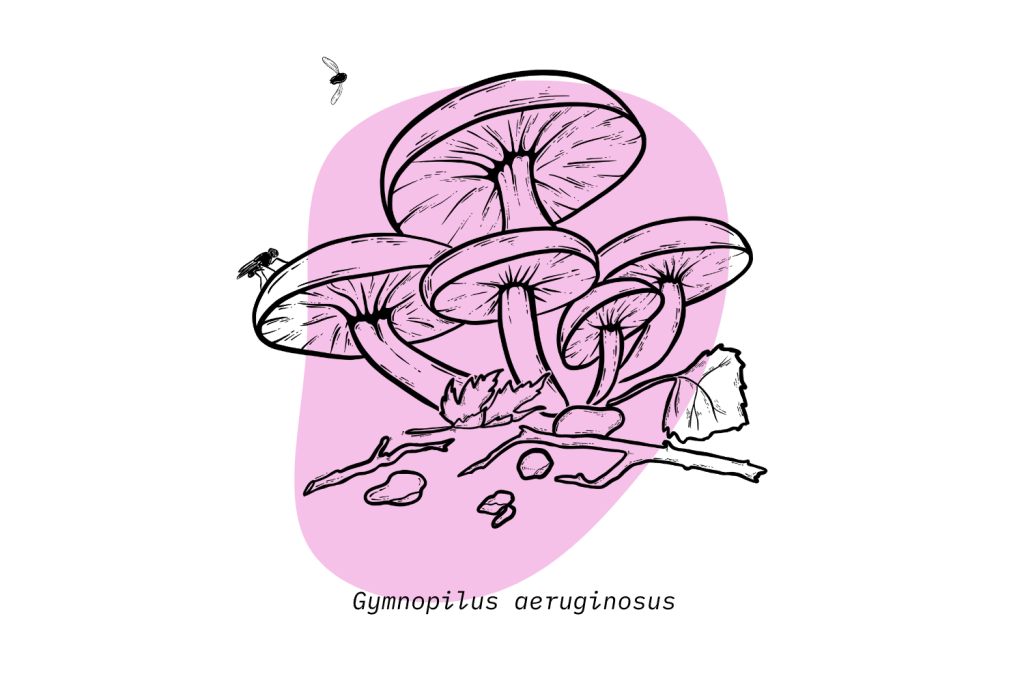
On the West Coast, from Mexico up to British Columbia, Canada, you’re most likely to find Gymnopilus aeruginosus or Gymnopilus luteofolius.
On the East coast, Gymnopilus luteus are much more common, but both G. aeruginosus and G luteofolius are also reported.
Outside of North America, Gymnopilus aeruginosus is common in Japan, Mongolia, and subtropical Southeast Asia. Gymnopilus luteofolius is found in warmer regions of Europe around Portugal and Spain.
7. Pluteus americanus
| Where it grows | US & Canada |
| Strength | ? |
| Where to look | Old-growth forests in North America |
| Cultivation difficulty | Moderate |
The Pluteus genus contains only a small number of psychedelic species. The most common is Pluteus americanus, which can be found throughout North America in old-growth forests.
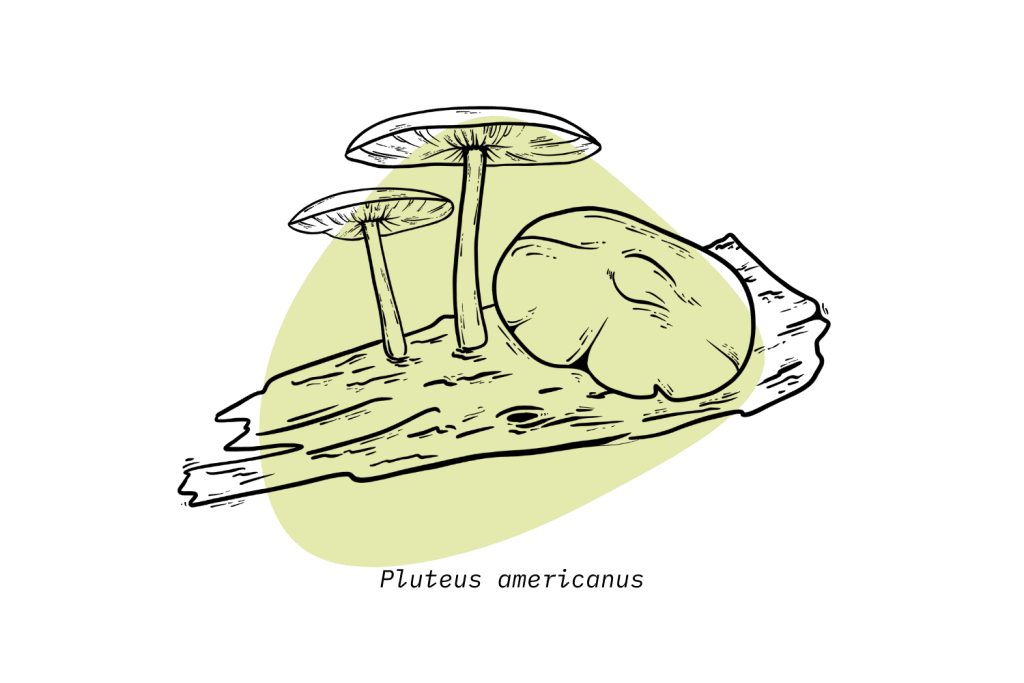
This species thrives on old, decaying wood and are notoriously difficult to cultivate. As more old-growth forests are being cut down in the US and Canada, these mushrooms are getting harder to find in the wild.
The unique identifying characteristic of this mushroom is the bright pink spores that stain the white gills of the mushroom as they mature.
8. Amanita muscaria
| Where it grows | Abundant across North America & Europe |
| Strength | ? (mostly oneirogenic) |
| Where to look | Near the base of deciduous trees in the fall. |
| Cultivation difficulty | Extremely Difficult |
Amanita muscaria is the only mushroom on this list that doesn’t contain psilocybin or psilocin. Instead, it contains the compounds ibotenic acid and muscimol, which act on the cholinergic system.
This mushroom is psychoactive but feels entirely different from conventional magic mushrooms.
The Amanita mushroom (AKA “the fly agaric”) is undeniably the most recognizable species of mushroom with its bright red and white-spotted caps and thick white stem.
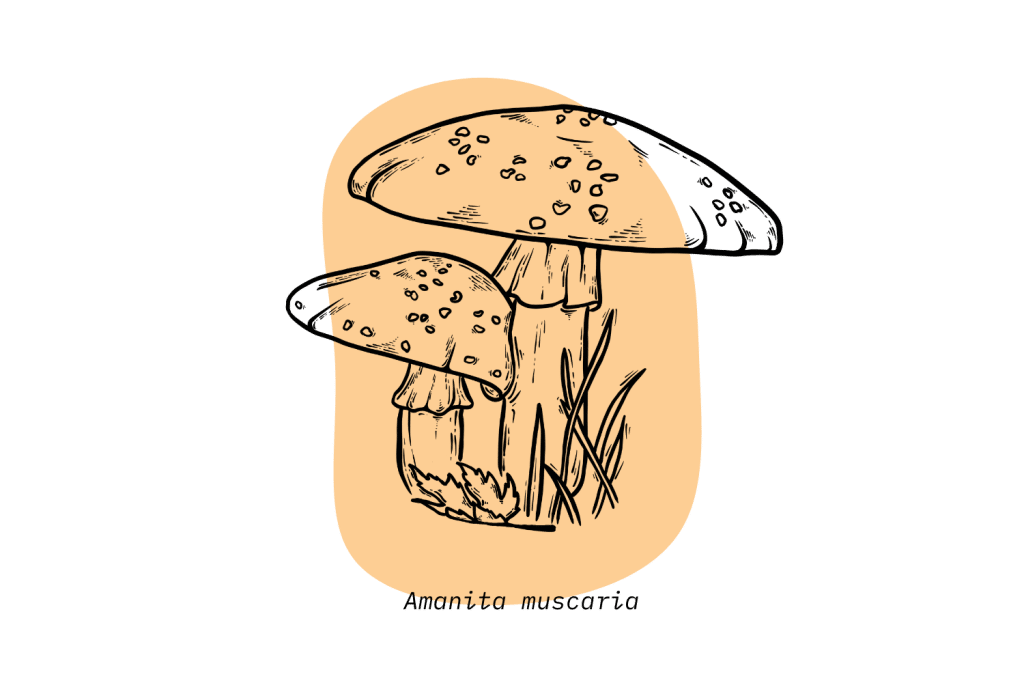
This species of mushroom is mycorrhizal, which means it forms a complex synergistic relationship with trees. This makes the amanita mushroom extremely difficult to cultivate.
You can find fly agarics growing near the base of pine, spruce, or birch trees in the late summer or fall. They’re abundant throughout temperate regions of the Northern Hemisphere, including Canada, the United States, most of Europe, Russia, Mongolia, China, and South Korea.
It’s rare to find this mushroom in tropical or subtropical climates or in the Southern Hemisphere.
Which Species of Shrooms Grow Near Me? Magic Mushrooms Around the World
Magic mushrooms are surprisingly abundant in areas inhabited by humans. You’ll be able to find at least one species of psilocybin-containing mushroom in every country on Earth, with the exception of Antarctica or the far north.
Below is an amalgamation of the hard work done by professional and amateur mycologists around the world. Websites such as The Mushroom Observer and The Shroomery enable users to submit their findings for identification help and to track sightings in different parts of the world.
Other excellent resources used to compile the list below include Psilocybin Mushrooms of the World (Paul Stamets), The Genus Psilocybe (Gaston Guzman), and Magic Mushrooms Around the World (Jochen Gartz).
Please reach out to feedback@tripsitter.com if you have any comments or suggestions to improve this list further.
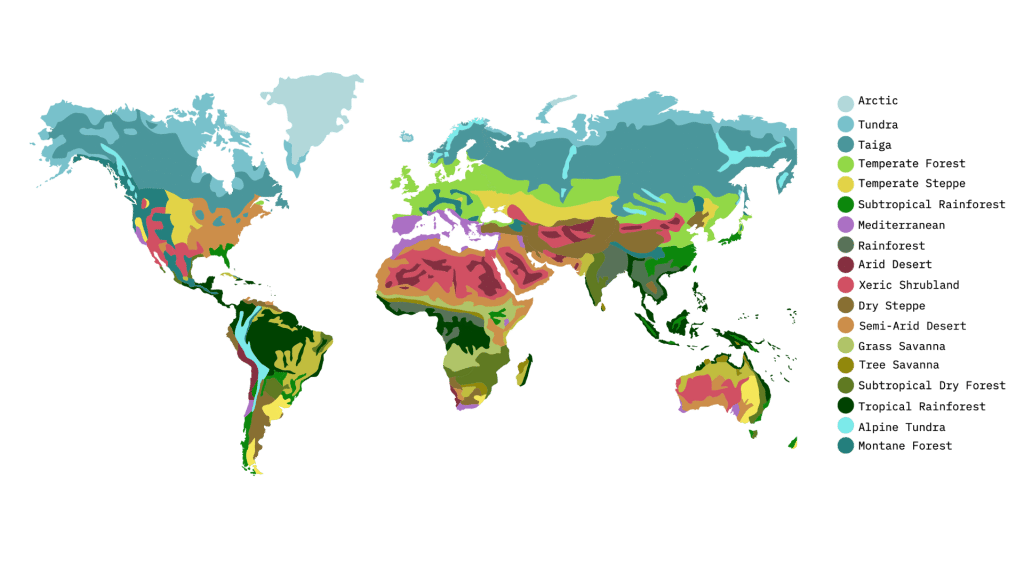
The United States 🇺🇸
The United States has a diverse range of climate zones due to its sheer size, presence of two separate oceans, mountains, and deserts. As a result, there are many species of psilocybin-containing mushrooms found in the US.
Because of this diversity, it’s difficult to generalize what mushrooms can be found here without further focusing on individual states.
- Alabama — Psilocybe caerulescens, Psilocybe cubensis, Panaeolus cyanescens, Panaeolus cinctulus
- Alaska — Gymnopilus sp., Psilocybe cyanescens, Panaeolus cinctulus, Panaeolus fimicola
- Arizona — Psilocybe hopii, Panaeolus cinctulus, Pluteus americanus
- Arkansas — Gymnopilus subspectabilis, Panaeolus cinctulus, Gymnopilus brandlei, Psilocybe ovoideocystidiata
- California — Gymnopilus thiersii, Massospora levispora, Pluteus phaeocyanopus, Psilocybe allenii, Psilocybe pelliculosa, Psilocybe semilanceata, Psilocybe stuntzii, Panaeolus cinctulus, Pluteus americanus, Psilocybe ovoideocystidiata, Panaeolus olivaceus
- Colorado — Massospora platypediae, Pluteus brunneidiscus, Psilocybe aztecorum, Panaeolus cinctulus, Pluteus americanus, Gymnopilus luteus
- Connecticut — Gymnopilus subspectabilis, Psilocybe aztecorum, Psilocybe caerulipes, Panaeolus cinctulus, Psilocybe ovoideocystidiata, Gymnopilus luteus
- Delaware — Gymnopilus subspectabilis, Panaeolus cinctulus, Gymnopilus luteus
- Florida — Panaeolus chlorocystis, Gymnopilus cyanopalmicola, Gymnopilus lepidotus, Gymnopilus peliolepis, Gymnopilus subtropicus, Pluteus sp., Psilocybe caerulescens, Panaeolus cyanescens, Gymnopilus luteoviridis, Panaeolus bisporus, Panaeolus fimicola, Psilocybe ovoideocystidiata, Gymnopilus palmicola, Psilocybe banderillensis
- Georgia — Psilocybe caerulescens, Psilocybe caerulipes, Psilocybe cubensis, Psilocybe tampanensis, Gymnopilus aeruginosus, Panaeolus olivaceus
- Hawaii — Panaeolus cambodginiensis, Panaeolus tropicalis, Panaeolus cyanescens, Panaeolus bisporus, Panaeolus cinctulus
- Idaho — Psilocybe silvatica, Gymnopilus aeruginosus, Gymnopilus luteofolius, Panaeolus cinctulus, Panaeolus olivaceus, Pholiotina cyanopus, Psilocybe fimetaria
- Illinois — Psilocybe silvatica, Gymnopilus sp., Inocybe insignis, Panaeolus cinctulus, Gymnopilus brandlei, Pluteus americanus, Gymnopilus luteus
- Indiana — Pholiotina smithii, Gymnopilus luteofolius, Panaeolus cinctulus, Gymnopilus brandlei, Pluteus americanus
- Iowa — Gymnopilus luteofolius, Gymnopilus luteus
- Kansas — Gymnopilus pulchrifolius
- Kentucky — Gymnopilus pulchrifolius, Psilocybe caerulipes, Panaeolus cinctulus, Pluteus americanus
- Louisiana — Psilocybe caerulescens, Psilocybe caerulipes, Gymnopilus aeruginosus, Panaeolus cinctulus, Gymnopilus junonius
- Maine — Pluteus sp., Psilocybe aztecorum, Panaeolus cinctulus, Panaeolus fimicola
- Maryland — Psilocybe stuntzii, Panaeolus cinctulus, Panaeolus fimicola, Psilocybe ovoideocystidiata
- Massachusetts — Psilocybe cyanescens, Psilocybe stuntzii, Psilocybe ovoideocystidiata, Gymnopilus luteus, Gymnopilus junonius
- Michigan — Massospora levispora, Pholiotina smithii, Pluteus saupei, Psilocybe silvatica, Psilocybe caerulipes, Gymnopilus aeruginosus, Gymnopilus luteofolius, Panaeolus cinctulus, Pluteus americanus, Gymnopilus luteus, Pholiotina cyanopus, Psilocybe liniformans
- Minnesota — Gymnopilus sp., Panaeolus cinctulus, Pluteus americanus, Gymnopilus luteus
- Mississippi — Psilocybe caerulescens, Psilocybe cubensis, Psilocybe tampanensis, Panaeolus cyanescens, Panaeolus cinctulus
- Missouri — Gymnopilus braendlei, Gymnopilus sp., Inocybe insignis, Psilocybe cubensis, Panaeolus cinctulus, Pluteus americanus, Psilocybe ovoideocystidiata
- Montana — Gymnopilus sp., Pholiotina smithii, Psilocybe aztecorum, Panaeolus cinctulus
- Nebraska — Gymnopilus sp., Gymnopilus luteofolius, Panaeolus cinctulus
- Nevada — Gymnopilus sp., Panaeolus cinctulus
- New Hampshire — Gymnopilus subspectabilis, Psilocybe caerulipes, Panaeolus cinctulus, Gymnopilus luteus
- New Jersey — Gymnopilus subspectabilis, Psilocybe graveolens, Psilocybe caerulipes, Panaeolus cinctulus, Psilocybe ovoideocystidiata, Gymnopilus luteus
- New Mexico — Massospora platypediae, Psilocybe mescaleroensis, Gymnopilus luteofolius, Panaeolus cinctulus
- New York — Gymnopilus validipes, Pholiotina smithii, Pluteus brunneidiscus, Psilocybe silvatica, Psilocybe caerulipes, Psilocybe cyanescens, Gymnopilus luteofolius, Panaeolus cinctulus, Panaeolus fimicola, Pluteus americanus, Psilocybe ovoideocystidiata, Panaeolus olivaceus, Gymnopilus luteus, Pholiotina cyanopus, Psilocybe liniformans
- North Carolina — Copelandia cyanescens, Psilocybe caerulescens, Psilocybe caerulipes, Psilocybe cubensis, Gymnopilus aeruginosus, Gymnopilus luteofolius, Panaeolus cinctulus, Psilocybe ovoideocystidiata, Gymnopilus junonius
- North Dakota — Gymnopilus sp., Panaeolus cinctulus
- Ohio — Inocybe insignis, Pluteus saupei, Psilocybe caerulipes, Gymnopilus aeruginosus, Gymnopilus luteofolius, Panaeolus bisporus, Panaeolus cinctulus, Psilocybe ovoideocystidiata, Gymnopilus luteus
- Oklahoma — Gymnopilus sp., Psilocybe cubensis, Panaeolus cinctulus
- Oregon — Gymnopilus thiersii, Pholiotina smithii, Psilocybe baeocystis, Psilocybe cyanofibrillosa, Psilocybe pelliculosa, Psilocybe sierrae, Psilocybe silvatica, Psilocybe azurescens, Psilocybe cyanescens, Psilocybe semilanceata, Psilocybe stuntzii, Gymnopilus aeruginosus, Gymnopilus viridans, Panaeolus cinctulus, Psilocybe ovoideocystidiata, Panaeolus olivaceus, Psilocybe fimetaria, Psilocybe liniformans
- Pennsylvania — Psilocybe caerulipes, Gymnopilus aeruginosus, Gymnopilus luteofolius, Panaeolus cinctulus, Pluteus americanus, Psilocybe ovoideocystidiata, Gymnopilus luteus
- Puerto Rico — Gymnopilus suberis, Gymnopilus subpurpuratus, Psilocybe moseri, Psilocybe portoricensis, Psilocybe caerulescens, Psilocybe cubensis, Panaeolus cyanescens, Panaeolus cinctulus, Panaeolus fimicola, Psilocybe banderillensis
- Rhode Island — Psilocybe caerulipes, Psilocybe stuntzii, Panaeolus cinctulus
- South Carolina — Gymnopilus subspectabilis, Inocybe insignis, Psilocybe caerulescens, Psilocybe caerulipes, Psilocybe cubensis, Psilocybe tampanensis, Panaeolus cyanescens, Panaeolus cinctulus, Gymnopilus luteus
- South Dakota — Panaeolus cinctulus
- Tennessee — Inocybe insignis, Pluteus albostipitatus, Psilocybe caerulipes, Psilocybe cubensis, Panaeolus cyanescens, Gymnopilus aeruginosus, Gymnopilus luteofolius, Panaeolus cinctulus, Panaeolus fimicola, Psilocybe ovoideocystidiata, Gymnopilus luteus
- Texas — Gymnopilus rufosquamulosus, Pluteus sp., Psilocybe caerulescens, Psilocybe cubensis, Panaeolus cyanescens, Gymnopilus aeruginosus, Gymnopilus luteoviridis, Gymnopilus luteofolius, Panaeolus cinctulus
- Utah — Gymnopilus sp., Massospora platypediae, Panaeolus cinctulus
- Vermont — Psilocybe aztecorum, Psilocybe caerulipes, Gymnopilus luteofolius, Panaeolus cinctulus, Gymnopilus luteus
- Virginia — Inocybe insignis, Psilocybe caerulipes, Psilocybe cubensis, Panaeolus cyanescens, Gymnopilus luteofolius, Panaeolus cinctulus, Psilocybe ovoideocystidiata, Gymnopilus luteus
- Washington — Gymnopilus braendlei, Pholiotina smithii, Psilocybe allenii, Psilocybe baeocystis, Psilocybe cyanofibrillosa, Psilocybe pelliculosa, Psilocybe silvatica, Psilocybe azurescens, Psilocybe cyanescens, Psilocybe semilanceata, Psilocybe stuntzii, Gymnopilus aeruginosus, Gymnopilus viridans, Gymnopilus luteofolius, Panaeolus bisporus, Panaeolus cinctulus, Panaeolus fimicola, Pluteus americanus, Psilocybe ovoideocystidiata, Panaeolus olivaceus, Pholiotina cyanopus, Psilocybe fimetaria, Psilocybe liniformans
- Washington DC — Gymnopilus braendlei, Gymnopilus sp., Panaeolus cinctulus, Psilocybe ovoideocystidiata
- West Virginia — Psilocybe caerulipes, Psilocybe cubensis, Panaeolus cinctulus, Psilocybe ovoideocystidiata, Gymnopilus luteus
- Wisconsin — Gymnopilus sp., Pholiotina smithii, Gymnopilus luteofolius, Panaeolus cinctulus, Pluteus americanus, Gymnopilus luteus
- Wyoming — Panaeolus cinctulus, Pluteus americanus
Canada 🇨🇦
Canada is the second-largest country in the world, but most of it remains uninhabitable due to the arctic climate. Most of the magic mushroom species found here grow along the far western and eastern coasts, or near the lower third of the country bordering the United States.
- Alberta — Conocybe kuehneriana, Gymnopilus sp., Gymnopilus luteofolius, Panaeolus cinctulus, Panaeolus sp.
- British Columbia — Pholiotina smithii, Pluteus brunneidiscus, Psilocybe baeocystis, Psilocybe cyanofibrillosa, Psilocybe pelliculosa, Psilocybe sierrae, Psilocybe silvatica, Psilocybe subfimetaria, Psilocybe cyanescens, Psilocybe semilanceata, Psilocybe stuntzii, Gymnopilus luteofolius, Panaeolus cinctulus, Pholiotina cyanopus, Psilocybe fimetaria
- New Brunswick — Psilocybe semilanceata, Panaeolus cinctulus, Gymnopilus luteus, Psilocybe fimetaria
- Newfoundland — Gymnopilus sp., Psilocybe semilanceata, Panaeolus cinctulus
- Nova Scotia — Gymnopilus subspectabilis, Psilocybe aztecorum, Psilocybe caerulipes, Psilocybe semilanceata, Panaeolus cinctulus
- Ontario — Gymnopilus speciosissimus, Massospora levispora, Pholiotina smithii, Psilocybe silvatica, Psilocybe caerulipes, Gymnopilus viridans, Panaeolus cinctulus, Pluteus americanus, Gymnopilus luteus, Panaeolus sp.
- Prince Edward Island — Gymnopilus sp., Psilocybe semilanceata, Panaeolus cinctulus
- Quebec — Gymnopilus speciosissimus, Psilocybe aztecorum, Psilocybe caerulipes, Psilocybe semilanceata, Gymnopilus viridans, Panaeolus cinctulus, Panaeolus olivaceus, Gymnopilus luteus, Pholiotina cyanopus
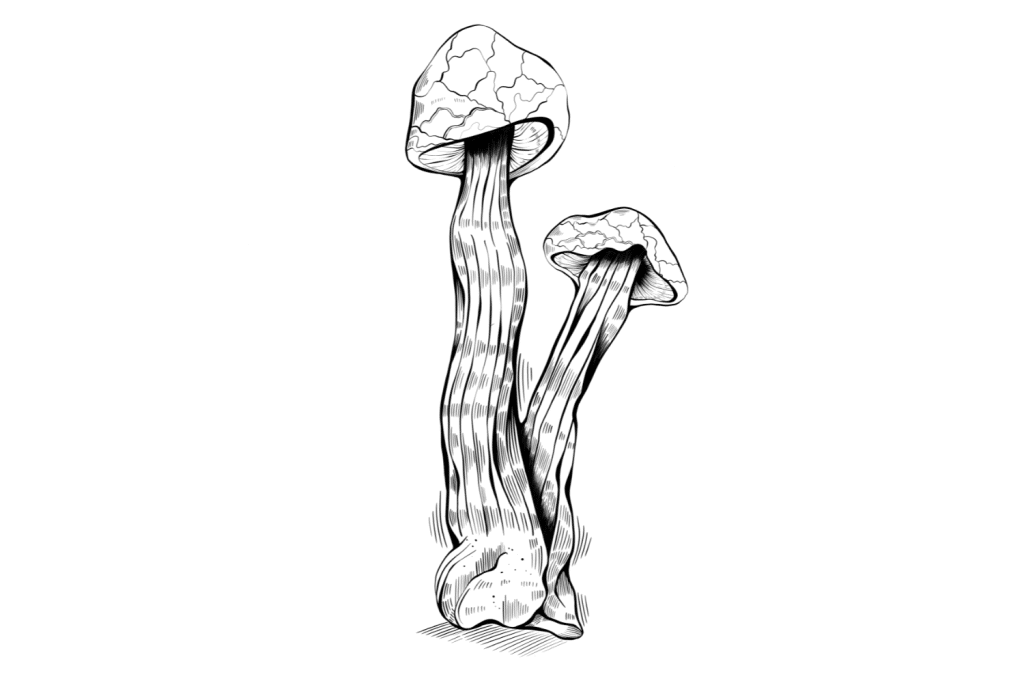
Europe
Europe is even more diverse than the United States. Gymnopilus is the most abundant genus of magic mushrooms here, but there are also plenty of members in the Panaeolus and Psilocybe genera that are common in temperate regions of Europe as well.
- Austria 🇦🇹 — Gymnopilus sp., Inocybe coelestium, Inocybe tricolor, Psilocybe medullosa, Psilocybe cyanescens, Panaeolus cyanescens, Inocybe corydalina, Panaeolus cinctulus, Panaeolus fimicola, Pholiotina cyanopus, Inocybe haemacta, Psilocybe serbica
- Belgium 🇧🇪 — Gymnopilus sp., Psilocybe cyanescens, Psilocybe semilanceata, Panaeolus cinctulus, Pholiotina cyanopus
- Bosnia 🇧🇦 — Gymnopilus sp., Panaeolus cinctulus, Psilocybe serbica
- Bulgaria 🇧🇬 — Gymnopilus sp., Psilocybe medullosa, Psilocybe cyanescens, Psilocybe semilanceata, Inocybe corydalina, Inocybe haemacta, Psilocybe serbica
- Croatia 🇭🇷 — Gymnopilus sp., Panaeolus cinctulus, Psilocybe fimetaria, Psilocybe serbica
- Czech Republic 🇨🇿 — Gymnopilus sp., Psilocybe arcana, Psilocybe medullosa, Psilocybe mairei, Psilocybe cyanescens, Psilocybe semilanceata, Inocybe corydalina, Pluteus salicinus, Panaeolus cinctulus, Panaeolus olivaceus, Psilocybe fimetaria, Psilocybe serbica, Psilocybe moravica
- Denmark 🇩🇰 — Gymnopilus sp., Psilocybe semilanceata, Panaeolus cinctulus, Panaeolus fimicola, Panaeolus olivaceus, Pholiotina cyanopus, Psilocybe fimetaria, Inocybe haemacta
- Estonia 🇪🇪 — Gymnopilus sp., Psilocybe medullosa, Psilocybe semilanceata, Pluteus salicinus, Panaeolus cinctulus, Panaeolus fimicola
- Faroe Islands 🇫🇴 — Gymnopilus sp., Panaeolus moellerianus, Psilocybe semilanceata, Panaeolus cinctulus
- Finland 🇫🇮 — Conocybe kuehneriana, Gymnopilus sp., Psilocybe medullosa, Psilocybe semilanceata, Pluteus salicinus, Panaeolus cinctulus, Panaeolus fimicola, Panaeolus olivaceus, Pholiotina cyanopus, Psilocybe fimetaria
- France 🇫🇷 — Gymnopilus sp., Panaeolus anomala, Psilocybe medullosa, Psilocybe cyanescens, Psilocybe semilanceata, Panaeolus cyanescens, Inocybe aeruginascens, Inocybe corydalina, Panaeolus cinctulus, Pholiotina cyanopus, Inocybe haemacta
- Germany 🇩🇪 — Galerina steglichii, Gymnopilus sp., Inocybe coelestium, Pluteus cyanopus, Pluteus villosus, Psilocybe mairei, Psilocybe cyanescens, Psilocybe semilanceata, Gymnopilus purpuratus, Inocybe aeruginascens, Inocybe corydalina, Pluteus salicinus, Panaeolus cinctulus, Panaeolus fimicola, Panaeolus sp., Pholiotina cyanopus, Inocybe haemacta, Psilocybe serbica, Psilocybe moravica
- Greece 🇬🇷 — Gymnopilus sp., Psilocybe bohemica, Psilocybe semilanceata, Panaeolus cinctulus, Panaeolus sp.
- Greenland 🇬🇱 — Gymnopilus sp., Panaeolus cinctulus, Panaeolus fimicola
- Netherlands 🇳🇱 — Inocybe corydalinavar, Psilocybe puberula, Psilocybe cyanescens, Psilocybe semilanceata, Gymnopilus purpuratus, Inocybe aeruginascens, Inocybe corydalina, Pluteus salicinus, Panaeolus cinctulus, Psilocybe liniformans, Inocybe haemacta, Psilocybe serbica
- Hungary 🇭🇺 — Gymnopilus sp., Pluteus nigroviridis, Inocybe aeruginascens, Panaeolus cinctulus, Pholiotina cyanopus, Psilocybe sp.
- Iceland 🇮🇸 — Psilocybe semilanceata, Panaeolus cinctulus, Panaeolus fimicola
- Italy 🇮🇹 — Gymnopilus sp., Psilocybe medullosa, Psilocybe puberula, Psilocybe cyanescens, Panaeolus cyanescens, Inocybe corydalina, Panaeolus cinctulus, Pholiotina cyanopus, Psilocybe serbica
- Ireland 🇮🇪 — Gymnopilus sp., Psilocybe cyanescens, Psilocybe semilanceata, Panaeolus cinctulus
- Kosovo 🇽🇰 — Psilocybe medullosa, Psilocybe semilanceata, Psilocybe serbica
- Latvia 🇱🇻 — Psilocybe semilanceata, Panaeolus cinctulus, Pholiotina cyanopus
- Lithuania 🇱🇹 — Gymnopilus sp., Psilocybe semilanceata, Panaeolus cinctulus
- Norway 🇳🇴 — Gymnopilus sp., Panaeolus cinctulus, Pholiotina cyanopus, Psilocybe fimetaria
- Poland 🇵🇱 — Psilocybe cyanescens, Psilocybe semilanceata, Pluteus salicinus, Psilocybe fimetaria
- Portugal 🇵🇹 — Psilocybe azurescens, Psilocybe semilanceata, Gymnopilus luteofolius, Pluteus salicinus, Psilocybe fimetaria
- Republic of Macedonia 🇲🇰 — Psilocybe semilanceata, Psilocybe serbica
- Romania 🇷🇴 — Gymnopilus sp., Psilocybe semilanceata, Panaeolus cinctulus, Psilocybe serbica
- Scotland 🏴 — Gymnopilus sp., Psilocybe semilanceata, Panaeolus cinctulus, Psilocybe fimicola
- Serbia 🇷🇸 — Gymnopilus sp., Psilocybe bohemica, Psilocybe cyanescens, Psilocybe semilanceata, Panaeolus cinctulus, Psilocybe serbica
- Slovakia 🇸🇰 — Gymnopilus sp., Psilocybe semilanceata, Panaeolus cinctulus, Psilocybe serbica
- Slovenia 🇸🇮 — Gymnopilus sp., Psilocybe semilanceata, Panaeolus cinctulus, Psilocybe serbica
- Spain 🇪🇸 — Gymnopilus sp., Pluteus brunneidiscus, Pluteus izurun, Psilocybe gallaeciae, Psilocybe hispanica, Psilocybe semilanceata, Panaeolus cyanescens, Inocybe corydalina, Pluteus salicinus, Panaeolus cinctulus, Psilocybe liniformans
- Sweden 🇸🇪 — Gymnopilus sp., Pholiotina smithii, Psilocybe medullosa, Psilocybe semilanceata, Panaeolus cinctulus, Pholiotina cyanopus, Psilocybe fimetaria, Psilocybe sp.
- Switzerland 🇨🇭 — Inocybe coelestium, Inocybe tricolor, Pluteus cyanopus, Pluteus villosus, Panaeolus cyanescens, Gymnopilus purpuratus, Inocybe corydalina, Pluteus salicinus, Panaeolus fimicola, Panaeolus olivaceus, Pholiotina cyanopus
- Turkey 🇹🇷 — Psilocybe semilanceata, Panaeolus fimicola
- Ukraine 🇺🇦 — Gymnopilus sp., Panaeolus cinctulus, Pholiotina cyanopus
- United Kingdom 🇬🇧 — Conocybe kuehneriana, Psilocybe cyanescens, Psilocybe semilanceata, Gymnopilus purpuratus, Inocybe corydalina, Pluteus salicinus, Panaeolus cinctulus, Panaeolus fimicola, Panaeolus olivaceus, Psilocybe fimetaria, Psilocybe liniformans, Inocybe haemacta
Central & South America
Most psilocybin-containing mushrooms thrive in the warmer climates of Central and South America. In fact, it’s here that Psilocybe and Panaeolus mushrooms are thought to have originated. This is where the original samples obtained by the likes of Terence and Dennis McKenna, as well as R. Gordon Wasson were first collected. It’s from these samples that mycologists have since been able to reproduce and spread all over the world.
- Argentina 🇦🇷 — Conocybe kuehneriana, Gymnopilus sp., Psilocybe collybioides, Psilocybe wrightii, Psilocybe cubensis, Psilocybe hoogshagenii, Psilocybe zapotecorum, Panaeolus cinctulus, Panaeolus fimicola, Panaeolus sp., Psilocybe alutacea
- Bahamas 🇧🇸 — Gymnopilus sp., Panaeolus cinctulus
- Bermuda 🇧🇲 — Gymnopilus sp., Panaeolus cyanescens, Panaeolus cinctulus
- Belize 🇧🇿 — Gymnopilus sp., Psilocybe cordispora, Psilocybe cubensis, Panaeolus cyanescens, Panaeolus cinctulus
- Bolivia 🇧🇴 — Panaeolus anomala, Gymnopilus sp., Psilocybe mammillata, Psilocybe cubensis, Panaeolus cyanescens, Panaeolus cinctulus, Psilocybe yungensis
- Brazil 🇧🇷 — Panaeolus anomala, Pluteus nigrolineatus, Psilocybe araucariicola, Psilocybe blattariopsis, Psilocybe brasiliensis, Psilocybe farinacea, Psilocybe furtadoana, Psilocybe paulensis, Psilocybe paupera, Psilocybe pericystis, Psilocybe rickii, Psilocybe subovoideocystidiata, Psilocybe uruguayensis, Psilocybe caerulescens, Psilocybe cubensis, Psilocybe hoogshagenii, Psilocybe zapotecorum, Panaeolus cyanescens, Panaeolus cinctulus, Panaeolus fimicola, Psilocybe banderillensis, Panaeolus sp., Psilocybe subtropicalis, Pluteus glaucotinctus, Psilocybe caeruleoannulata
- Chile 🇨🇱 — Conocybe kuehneriana, Pluteus glaucus, Psilocybe carbonaria, Psilocybe sierrae, Psilocybe subfimetaria, Psilocybe zapotecorum, Gymnopilus purpuratus, Panaeolus cinctulus, Panaeolus sp., Psilocybe liniformans, Psilocybe caeruleoannulata
- Colombia 🇨🇴 — Panaeolus cambodginiensis, Psilocybe columbiana, Psilocybe guatapensis, Psilocybe pintonii, Psilocybe plutonia, Psilocybe semiangustipleurocystidiata, Psilocybe subacutipilea, Psilocybe caerulescens, Psilocybe cubensis, Psilocybe hoogshagenii, Psilocybe zapotecorum, Panaeolus cinctulus, Panaeolus sp., Psilocybe yungensis
- Costa Rica 🇨🇷 — Gymnopilus sp., Psilocybe aztecorum, Psilocybe caerulescens, Psilocybe cubensis, Psilocybe mexicana, Psilocybe hoogshagenii, Psilocybe zapotecorum, Panaeolus cyanescens, Panaeolus cinctulus, Psilocybe banderillensis, Psilocybe yungensis
- Ecuador 🇪🇨 — Dictyonema huaorani, Gymnopilus sp., Psilocybe subcubensis, Psilocybe caerulescens, Psilocybe zapotecorum, Panaeolus cinctulus, Psilocybe yungensis
- El Salvador 🇸🇻 — Gymnopilus sp., Psilocybe cubensis, Panaeolus cinctulus
- French Guiana 🇬🇫 — Gymnopilus sp., Psilocybe cubensis, Panaeolus cyanescens, Panaeolus cinctulus, Psilocybe subtropicalis
- Guatemala 🇬🇹 — Gymnopilus sp., Psilocybe caerulescens, Psilocybe cubensis, Psilocybe mexicana, Psilocybe zapotecorum, Panaeolus cinctulus
- Guyana 🇬🇫 — Gymnopilus sp., Psilocybe cubensis, Panaeolus cyanescens, Panaeolus cinctulus
- Honduras 🇭🇳 — Gymnopilus sp., Psilocybe cubensis, Panaeolus cyanescens, Panaeolus cinctulus
- Mexico 🇲🇽 — Conocybe siligineoides, Gymnopilus cyanopalmicola, Panaeolus venezolanus, Pluteus leucocyanescens, Psilocybe heimii, Psilocybe meridionalis, Psilocybe moseri, Psilocybe muliercula, Psilocybe neoxalapensis, Psilocybe aztecorum, Psilocybe hoogshagenii, Psilocybe zapotecorum, Panaeolus cyanescens, Inocybe corydalina, Panaeolus cinctulus, Pluteus americanus, Psilocybe banderillensis, Psilocybe subtropicalis, Psilocybe yungensis
- Nicaragua 🇳🇮 — Gymnopilus sp., Psilocybe caerulescens, Psilocybe cubensis, Psilocybe mexicana, Psilocybe zapotecorum, Panaeolus cinctulus, Psilocybe yungensis
- Panama 🇵🇦 — Gymnopilus sp., Psilocybe caerulescens, Psilocybe cubensis, Psilocybe mexicana, Psilocybe zapotecorum, Panaeolus cyanescens, Panaeolus cinctulus, Psilocybe subtropicalis, Psilocybe yungensis
- Paraguay 🇵🇾 — Psilocybe cubensis, Panaeolus cyanescens, Panaeolus cinctulus
- Peru 🇵🇪 — Pluteus sp., Psilocybe cubensis, Psilocybe zapotecorum, Panaeolus cinctulus, Psilocybe yungensis
- Suriname 🇸🇷 — Gymnopilus sp., Psilocybe cubensis, Panaeolus cyanescens, Panaeolus cinctulus
- Uruguay 🇺🇾 — Psilocybe uruguayensis, Psilocybe cubensis, Panaeolus cinctulus, Psilocybe caeruleoannulata
- Venezuela 🇻🇪 — Panaeolus venezolanus, Psilocybe meridensis, Psilocybe plutonia, Psilocybe caerulescens, Psilocybe cubensis, Psilocybe zapotecorum, Panaeolus cyanescens, Panaeolus cinctulus, Panaeolus sp., Psilocybe yungensis
The Caribbean
The Caribbean is small in terms of landmass, so unsurprisingly there’s less diversity here in terms of magic mushroom species than in other parts of the world. Nevertheless, the climate is perfect for many species of Psilocybe, Panaeolus, and Gymnopilus mushrooms. You’re most likely to find these shrooms around ranchlands or small, rural communities.
- Cuba 🇨🇺 — Psilocybe plutonia, Psilocybe cubensis, Panaeolus cinctulus, Gymnopilus palmicola
- Dominican Republic 🇩🇴 — Gymnopilus sp., Psilocybe cubensis, Panaeolus cinctulus
- Grenada 🇬🇩 — Gymnopilus sp., Panaeolus cyanescens, Panaeolus cinctulus
- Haiti 🇭🇹 — Gymnopilus sp., Panaeolus cyanescens, Panaeolus cinctulus
- Jamaica 🇯🇲 — Gymnopilus sp., Psilocybe fuliginosa, Psilocybe mammillata, Psilocybe cubensis, Panaeolus cyanescens, Panaeolus cinctulus, Psilocybe fimicola
- Puerto Rico 🇵🇷 — Gymnopilus subpurpuratus, Psilocybe moseri, Psilocybe portoricensis, Psilocybe caerulescens, Psilocybe cubensis, Panaeolus cyanescens, Panaeolus cinctulus, Panaeolus fimicola, Psilocybe banderillensis, Panaeolus sp.
- Trinidad 🇹🇹 — Gymnopilus sp., Psilocybe cubensis, Panaeolus cyanescens, Panaeolus cinctulus
Africa
Magic mushrooms are most common in moist tropical regions of Africa, such as Burundi, Comoros, Djibouti, Eritrea, Ethiopia, Kenya, Madagascar, Malawi, Mauritius, Mayotte, Mozambique, Reunion, Rwanda, Seychelles, Somalia, Tanzania, and Uganda.
However, you’ll notice the longest list of known magic mushrooms is in South Africa. This is more likely the result of more people documenting the species discovered here than in other parts of the country. The dry, semi-arid climate here is not optimal for most magic mushroom species.
- Algeria 🇩🇿 — Gymnopilus sp., Psilocybe mairei, Panaeolus cinctulus
- Chad 🇹🇩 — Gymnopilus sp., Panaeolus africanus, Panaeolus cinctulus
- Democratic Republic of the Congo 🇨🇬 — Gymnopilus sp., Pluteus thoenii, Psilocybe congolensis, Panaeolus cinctulus, Pluteus glaucotinctus
- Kenya 🇰🇪 — Gymnopilus sp., Psilocybe aquamarina, Psilocybe subaeruginascens, Psilocybe cubensis, Panaeolus cyanescens, Panaeolus cinctulus
- Madagascar 🇲🇬 — Gymnopilus sp., Panaeolus cyanescens, Panaeolus cinctulus
- Mauritius 🇲🇺 — Gymnopilus sp., Panaeolus cyanescens, Panaeolus cinctulus
- Morocco 🇲🇦 — Gymnopilus sp., Psilocybe mairei, Panaeolus cinctulus
- Sudan 🇸🇩 — Gymnopilus sp., Panaeolus africanus, Psilocybe mairei, Panaeolus cinctulus
- South Africa 🇿🇦 — Gymnopilus subearlei, Gymnopilus igniculus, Gymnopilus purpureosquamulosus, Psilocybe natalensis, Psilocybe subaeruginascens, Psilocybe cubensis, Psilocybe cyanescens, Panaeolus cyanescens, Inocybe aeruginascens, Panaeolus bisporus, Panaeolus cinctulus, Panaeolus fimicola, Panaeolus olivaceus, Pluteus glaucotinctus, Gymnopilus dilepis, Psilocybe sp.
- Uganda 🇺🇬 — Psilocybe subaeruginascens, Psilocybe cubensis, Panaeolus cinctulus
- Zimbabwe 🇿🇼 — Gymnopilus sp., Psilocybe cubensis, Panaeolus cinctulus
Asia
Mushrooms are abundant in Southeast Asia, temperate forested regions of central and northern Asia, as well as various humid islands like Japan.
- Bhutan 🇧🇹 — Gymnopilus sp., Psilocybe subaeruginascens, Panaeolus sp.
- Cambodia 🇰🇭 — Gymnopilus sp., Panaeolus cambodginiensis, Panaeolus tropicalis, Psilocybe cubensis, Panaeolus cyanescens, Panaeolus cinctulus, Psilocybe sp.
- China 🇨🇳 — Panaeolus axfordii, Psilocybe baeocystis, Psilocybe cinnamomea, Psilocybe keralensis, Psilocybe pelliculosa, Psilocybe venenata, Psilocybe wayanadensis, Psilocybe samuiensis, Panaeolus sp., Psilocybe yungensis, Psilocybe sp., Psilocybe angulospora, Psilocybe subcaerulipes
- India 🇮🇳 — Copelandia tropica, Gymnopilus sp., Panaeolus africanus, Panaeolus cyannoanulatus, Panaeolus lepus-stercus, Panaeolus tirunelveliensis, Panaeolus tropicalis, Panaeolus venezolanus, Pluteus padanilis, Psilocybe indica, Psilocybe keralensis, Psilocybe natarajanii, Psilocybe pseudoaztecorum, Psilocybe subaeruginascens, Psilocybe wayanadensis, Psilocybe aztecorum, Psilocybe cubensis, Psilocybe semilanceata, Panaeolus cyanescens, Inocybe corydalina, Panaeolus bisporus, Panaeolus cinctulus, Panaeolus olivaceus, Psilocybe subtropicalis
- Indonesia 🇮🇩 — Gymnopilus sp., Psilocybe aerugineomaculans, Psilocybe eximia, Psilocybe subaeruginascens, Psilocybe cubensis, Panaeolus cinctulus
- Israel 🇮🇱 — Inocybe tricolor, Panaeolus fimicola
- Japan 🇯🇵 — Gymnopilus orientispectabilis, Psilocybe septentrionalis, Psilocybe subaeruginascens, Psilocybe venenata, Psilocybe cubensis, Panaeolus cyanescens, Gymnopilus aeruginosus, Panaeolus cinctulus, Psilocybe subcaerulipes, Psilocybe argentipes
- Korea 🇰🇷 — Panaeolus cyanescens, Panaeolus cinctulus, Gymnopilus junonius, Psilocybe subcaerulipes, Psilocybe papuana
- Laos 🇱🇦 — Psilocybe cf. subcaerulipes, Psilocybe cubensis, Panaeolus cyanescens, Panaeolus cinctulus
- Mongolia 🇲🇳 — Gymnopilus aeruginosus
- Nepal 🇳🇵 — Psilocybe cubensis, Psilocybe sp.
- Pakistan 🇵🇰 — Gymnopilus dunensis
- Philippines 🇵🇭 — Gymnopilus sp., Psilocybe cubensis, Panaeolus cyanescens, Panaeolus cinctulus
- Russia 🇷🇺 — Gymnopilus sp., Pluteus brunneidiscus, Psilocybe medullosa, Pluteus salicinus, Panaeolus cinctulus, Pluteus americanus, Pholiotina cyanopus
- Sri Lanka 🇱🇰 — Gymnopilus sp., Psilocybe rostrata, Psilocybe cubensis, Panaeolus cinctulus
- Thailand 🇹🇭 — Gymnopilus sp., Panaeolus axfordii, Psilocybe magnispora, Psilocybe thaiaerugineomaculans, Psilocybe thaicordispora, Psilocybe thaiduplicatocystidiata, Psilocybe cubensis, Panaeolus cyanescens, Psilocybe samuiensis, Panaeolus cinctulus, Gymnopilus dilepis, Psilocybe subcaerulipes
- Vietnam 🇻🇳 — Gymnopilus sp., Panaeolus rubricaulis, Psilocybe cubensis, Panaeolus cyanescens, Psilocybe samuiensis
Australia 🇦🇺
Australia is largely a hot and arid continent unfit for mushrooms. However, the coastline is intensely vibrant. There are many magic mushroom species that can be found extending from the tropical regions of Northern Australia and the ancient Daintree rainforest, down to the southern tip of Tasmania, which has a more temperate climate.
- Australian Capital Territory — Gymnopilus sp., Panaeolus cinctulus, Psilocybe subaeruginosa
- New South Wales — Gymnopilus sp., Psilocybe cubensis, Panaeolus cyanescens, Panaeolus cinctulus, Psilocybe papuana, Psilocybe subaeruginosa, Psilocybe alutacea, Psilocybe tasmaniana
- Northern Territory — Gymnopilus sp., Psilocybe cubensis, Panaeolus cyanescens, Panaeolus cinctulus
- Queensland — Gymnopilus sp., Psilocybe cubensis, Panaeolus cyanescens, Panaeolus cinctulus, Psilocybe subaeruginosa
- South Australia — Gymnopilus sp., Gymnopilus purpuratus, Panaeolus cinctulus, Psilocybe subaeruginosa, Psilocybe alutacea
- Tasmania — Gymnopilus sp., Psilocybe semilanceata, Panaeolus cinctulus, Psilocybe subaeruginosa, Psilocybe alutacea
- Victoria — Gymnopilus sp., Psilocybe semilanceata, Gymnopilus purpuratus, Panaeolus cinctulus, Psilocybe subaeruginosa, Psilocybe alutacea
- Western Australia — Gymnopilus sp., Gymnopilus purpuratus, Panaeolus cinctulus, Psilocybe alutacea
Oceania
Oceana is incredibly widespread and disconnected from the rest of the world. The fact that magic mushrooms can be found here at all is a tribute to their incredible capacity to travel. The spores of magic mushrooms are so small they’ve been discovered traveling through wind currents in the stratosphere. If even one of these spores manages to land on the rich tropical soil of one of these islands, it could be enough for the mushrooms to take hold.
This is thought to be the case as there are several entirely distinct species found on some of these islands (suggesting separate evolution, rather than the human introduction of known species from Europe or North America).
- New Guinea 🇵🇬 — Gymnopilus sp., Panaeolus rubricaulis, Psilocybe kumaenorum, Panaeolus cinctulus
- Fiji 🇫🇯 — Copelandia cyanescens
- French Polynesia 🇵🇫 — Gymnopilus purpurascens
- New Zealand 🇳🇿 — Gymnopilus sp., Panaeolopsis nirimbii, Psilocybe makarorae, Psilocybe subsecotioides, Pluteus velutinornatus, Psilocybe aucklandii, Psilocybe cyanescens, Psilocybe semilanceata, Gymnopilus purpuratus, Panaeolus cinctulus, Psilocybe angulospora, Psilocybe papuana, Psilocybe subaeruginosa, Psilocybe alutacea, Psilocybe tasmaniana
- Vanuatu 🇻🇺 — Gymnopilus sp., Psilocybe cubensis, Panaeolus cyanescens
How to Identify Magic Mushrooms
The general rule of thumb for identifying magic mushrooms is to check for the blueing reaction and take a spore print. If the mushroom bruises blue and leaves behind a dark purple or black spore print — it’s most likely a species of Psilocybe spp. or Panaeolus spp.
Here are some more in-depth tips for identifying magic mushrooms in the wild.
1. Check For The Psilocybin “Blueing Reaction”
One of the key features used to identify psilocybin-containing mushrooms is the blueing reaction.
This reaction is catalyzed by the psilocybin itself as it becomes oxidized — so species that lack this compound won’t bruise blue.
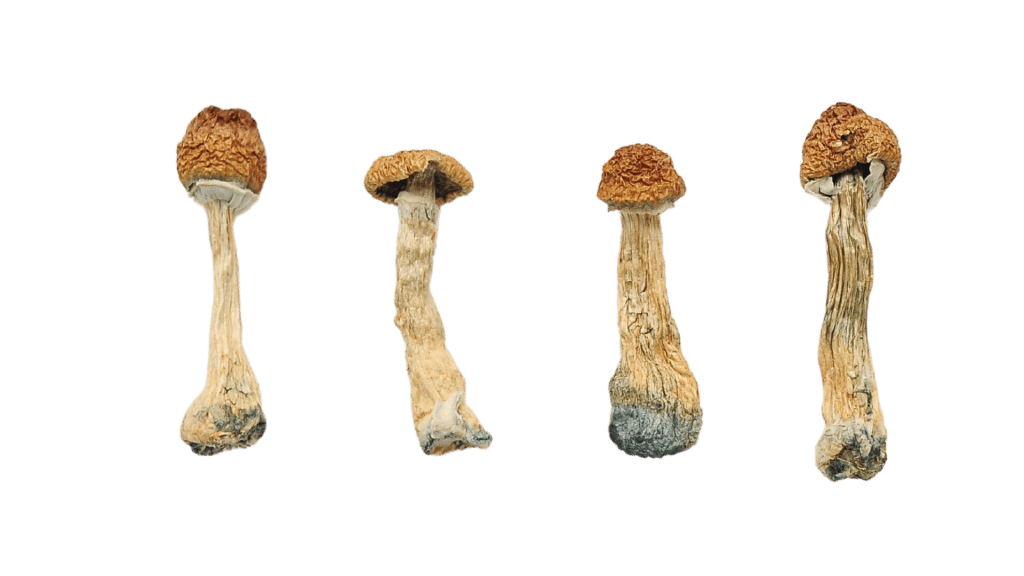
The blueing reaction is the most reliable method of properly identifying magic mushrooms. However, some shrooms have a blueish tinge for other reasons, so it’s important to differentiate blueing that forms from oxidation (physically bruising or damaging the shroom), and blueing that’s present from pigments in the mushroom itself.
2. Collect Spore Prints
The spores of mushrooms are one of the most reliable ways of determining the species of an unknown sample.
The process involves collecting spores by placing a mushroom cap over a piece of tinfoil or parchment paper and allowing the spores to drop over the course of an hour or two. If your goal is simply to determine the color, you can use a white piece of paper and usually get a good idea of the color within about 20 or 30 minutes instead.
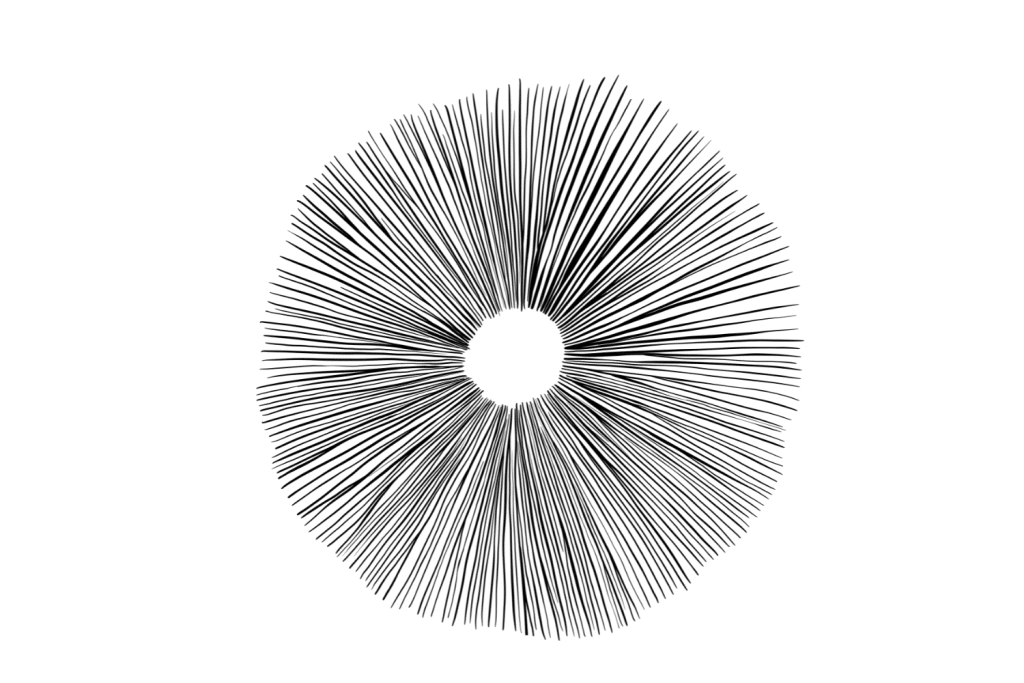
The first piece of information comes from the colors of the spores — are they white, black, or purple? Most species of magic mushrooms produce a dark purple or black sporeprint.
The next bit of assessment requires a microscope. The shape and various features of the spores can be compared against samples in a database, along with other distinguishing features of the mushroom to elucidate the species. This step isn’t always necessary but provides further data points to rock-solid identification.
3. Familiarize Yourself With Deadly Look-Alikes
There are dozens of different species of magic mushrooms, some easier to identify than others. Unfortunately, most psychedelic mushrooms lack key distinguishing features. They have a very generic appearance — small, brown, and growing in forests, grassy areas, and pastures. Many poisonous species share these same descriptive qualities.
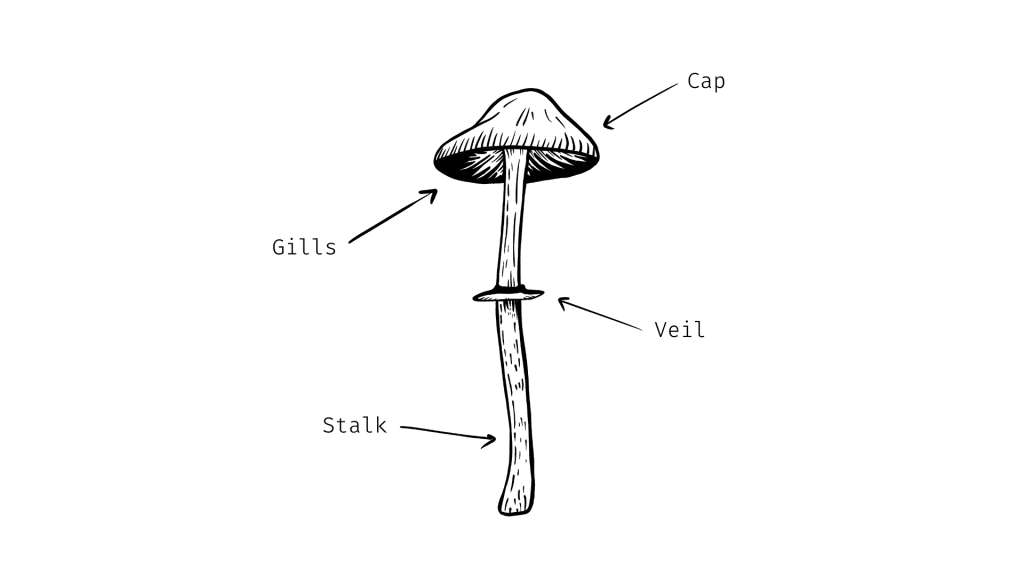
If your intention is to go out harvesting wild magic mushrooms, it’s imperative you’re familiar with the poisonous lookalikes and understand the techniques necessary for differentiating these species.
Never eat or distribute a mushroom you aren’t able to identify conclusively.
List of common poisonous mushrooms to be aware of:
- Galerina marginata
- Conocybe filaris
- Clitocybe rivulosa
- Paxillus involutus
- Coprinopsis atramentaria
- Cortinarius rubellus
- Amanita phalloides
4. Submit Your Findings to Public ID Forums
The mushroom community is very active, and there is plenty of amateur and professional mycologists alike that are eager to help identify the species you find out in the wild.
My favorite place to submit findings is /r/shroomid or Shroomery.
You’ll need to include the following information with your submission:
- Where the sample was found
- Two or three clear images of the mushroom from different angles
- A picture of the spore print (if possible)
Keep in mind these forums should only serve as a second opinion. You still need to understand the fundamentals of shroom identification on your own if you plan to eat any of the mushrooms you find.
Best Books on Mushroom Foraging
Getting started with mushroom foraging is free — all you need to do is get out into an area where mushrooms are known to grow and start looking. But if you want to actually harvest any of the mushrooms you find, you’ll need an identification book.
Learning about the subtle differences between psilocybin-containing shrooms and poisonous lookalikes requires some skill.
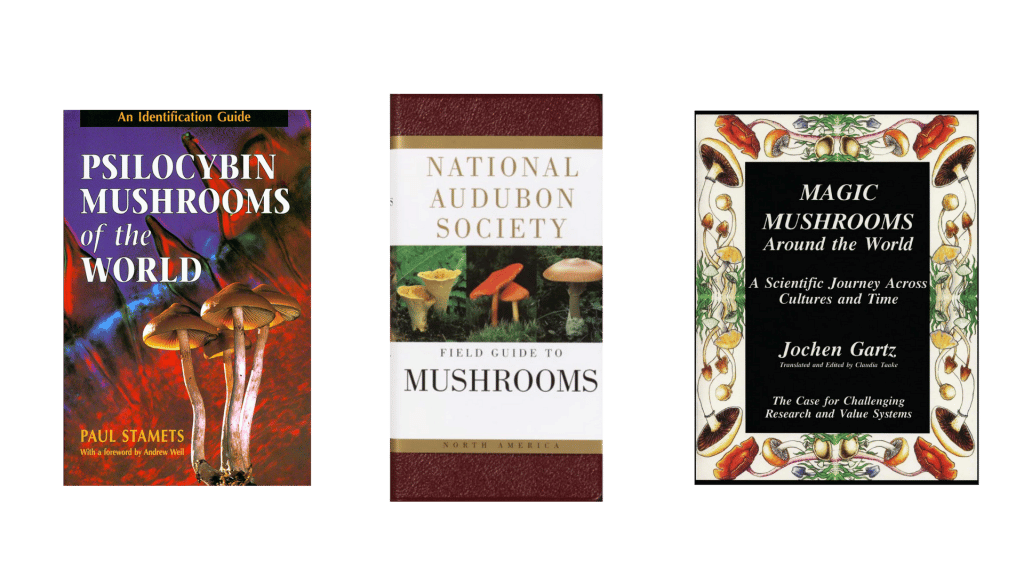
Understanding how to tell the difference between attached, notched, and free gills; learning how to collect sporeprints, and understanding the different types of veils is essential for differentiating poisonous mushrooms from psychedelic mushrooms. A good guidebook is essential for any mushroom forager, regardless of how much experience they have.
Here are some of the best guidebooks I’ve found so far or foraging magic mushrooms:
- Psilocybe Mushrooms of the World — Paul Stamets
- The Genus Psilocybe — Gaston Guzman
- Magic Mushrooms Around the World — Jochen Gartz
- Mushrooms Demystified — David Aurora (General Mushroom Guide)
- Mushrooms — Roger Phillips (General Mushroom Guide)
- Field Guide to Mushrooms — The National Audubon Society (General Mushroom Guide)(General Mushroom Guide)
Related: Essential List of Psychedelic Literature.
How Do I Store My Mushrooms After I’ve Found Them?
Once you’ve collected your mushrooms, the clock starts ticking. Your mushrooms will last several hours once harvested but will need to either be dried out for long-term storage or placed in the refrigerator if you intend to eat them fresh.
You can store magic mushrooms for around 3–5 days in the fridge or for several months dried if kept in a cool, dark, sealed container.
Drying mushrooms can be as simple as placing your harvest on a plate with a piece of paper towel covering it or using more advanced tools like a food dehydrator.
Also see: Top 5 Mushroom Grow Kits (2022)
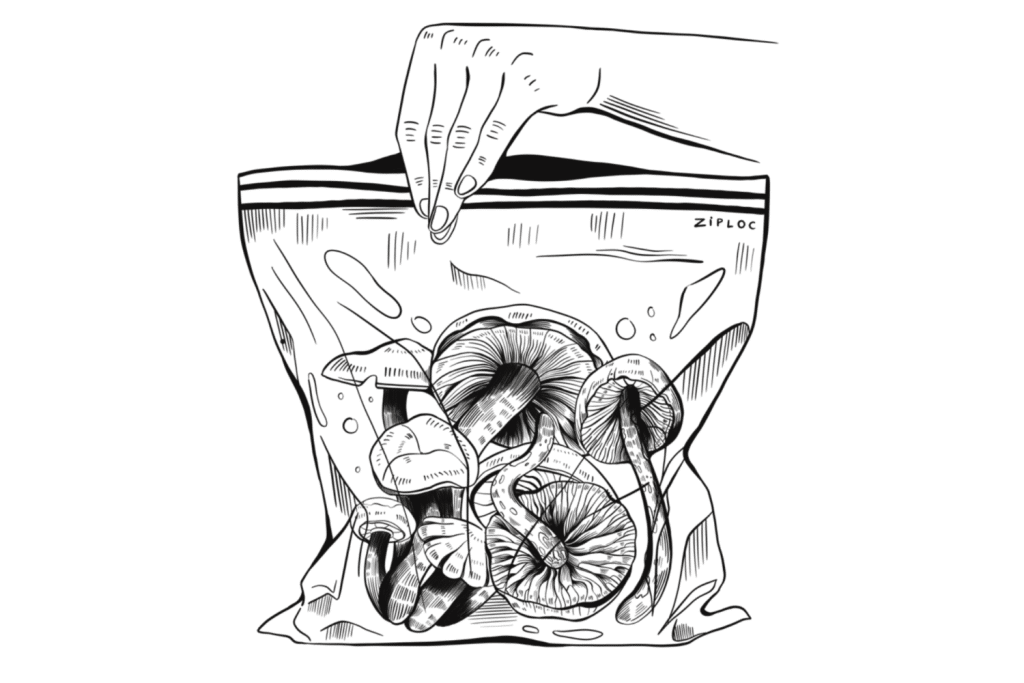
Key Takeaways: Where Do Magic Mushrooms Grow?
Magic mushrooms are surprisingly abundant in the world around us. Many species have coexisted with humans and can be found most easily in areas surrounding human developments or in city parks.
Look for places that remain humid for most of the spring, summer, or fall, such as in shaded woodlands or parks. They’ll often be found poking up through forests with plenty of leaf cover or near the base of trees or buildings.
Many species of magic mushrooms thrive on manure and animal droppings, so they’ll be especially abundant in farmlands that host livestock.


